Odds and Sods
Many
Chicago-related artists are on a
separate page, as are some Memphis
bands.
Aerosmith
Things were changing around 1973. Most West Coast
bands were
dead, irrelevant or into country rock. Prog-rock, glam, and
early metal were now mainstays of music, and even the Stones were
into country and gospel. What to do then to find some middle
ground not really tainted by folk, jazz, country, classical or any of
those other pesky genres that got stirred together in the late
1970s? The answer is affectionately referred to as cock-rock:
taking the old blues and R&B sound (a la Stones), adding loud
metal-level guitars without the speed or technical precision (a la
Sabbath on quaaludes) and keeping the lyrics relatively
simple.
Granted, a lot of what I just wrote is conjecture - I need to hear
more Montrose, early Kiss and others before really passing
judgment.
This sort-of movement is probably analogous to Britain's pub-rock
scene, I am entirely ignorant about how it sounds since the latter
never really crossed over into the US.
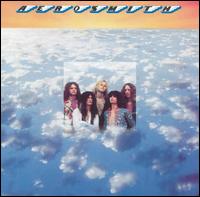 Aerosmith
(Jan. 1973),
***1/2
Aerosmith
(Jan. 1973),
***1/2
It
would be real
easy to dismiss these guys as Stones knock-offs, but there's more to
the story. At their base, Aerosmith took the
early Stones'
R&B and made it heavier and louder. Vocalist Steven
Tyler's voice (sometimes you can almost hear the Jagger swagger), his
old-school harmonica ("One Way Street") and the occasional
added saxophone ("Mama Kin") all attest to this influence.
They even close the album with the same song that concludes the
Stones debut (the slightly goofy "Walkin' the Dog").
But while the real Stones were messing around with the real blues,
gospel, country and God knows what, Aerosmith only truly breaks the
mold once (the excellent "Stairway to Heaven" carbon copy
"Dream On" which became a hit when re-released a few years
later), and only approach actual blues once (the beginning of "Movin'
Out"). All of that being said, the album is quite good
because the songs, while relatively straightforward and
interchangeable, are for the most part good. Even their
filler
doesn't rely on formula (some unexpected shifts in "Movin' Out")
unlike some old British R&B bands. The
instrumentation
isn't built around speed like a metal band, and solos sound more like
solos than riffs. The guitars are simply good, sticking with
a
simple power chord deviation which can get tiring, but still better
than say, Slade. So
- loud, easy to
understand, direct and not terribly innovative, but still a good
time. Band is Steven Tyler (vocals), Joe Perry (lead guitar),
Brad Whitford (rhythm guitar), Tom Hamilton (bass) and Joey Kramer
(drums). Tyler wrote most of the songs. Produced by
Adrian Barber.
(LP Columbia PC
32005).
Man,
that is one cheap
album cover.
Arbuckle
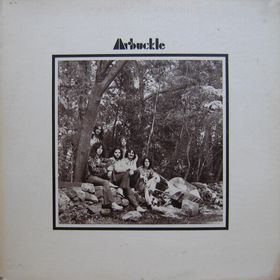 Arbuckle
(1972), *
Arbuckle
(1972), *
Strike
1: Naming your band after deceased, disgraced film star Fatty
Arbuckle.
Strike 2:
Blowing AM Gold. Arbuckle plays that sort of light folky/country
music sold on TV infomercials as “AM Gold.” The genre has
not aged well, and rarely rocked. There are some good AM Gold artists
– Jim Croce, Hamilton, Jo Frank & Reynolds had that one
song, the obscure Clean Living, maybe a couple others, but mainly
just a lot of wussy, unpopular stuff.
I won’t
even bother breaking down the album’s individual tracks. The
group appears to have been lead by Ronnie Fierstein, who sings lead,
and does some guitar and keyboard work. Fierstein is not a good
singer. He’s not terrible, but lacks a strong voice, has an odd
little accent, and his vibrato is goofy. When the first person he
reminds you of has a strong Lancashire accent (Pat Moran of Spring)
you know this is trouble. While Fierstein sings some moderately bad
lead vocals, what caps this album off is the songwriting. These
lyrics suck. Suck in a real bad way. Every song runs like this: I
think the world is beautiful, now that you are here, or I was
wondering, but now I found you, or blah blah blah. It is all the
same, with a couple of minor exceptions (equally bad), and Fierstein
wrote most of it. Thanks, Fierstein.
About the
guitars – there seem to be a lot of them. Did I mention there
are six people in this band? Six, with three playing some guitar.
That’s an awful lot of not very interesting guitar. Nobody in
the band does much musically – there is only one noticeable
guitar solo on the whole record from lead guitarist Steve Addabbo,
and it only supplements the none too interesting chord changes these
guys use. You will never see this album, but if you feel like AM
Gold, get some Jim Croce instead. Bad, bad, bad.
The band is
Ronnie Fierstein (lead vocals, acoustic guitar, some keys), Jan Flato
(keyboards), Steve Addabbo (guitars), Gil Bowen (more guitars,
flute), Rolf Berntsen (drums), and Joe DeChaves (bass). I think these
guys were from New York, as the label (Musicor – never heard of
it either) and studio were located there. Produced by Vic Millrose
and Alan Bernstein. Addabbo later produced Suzanne Vega and a host of
other artists in that vein. Everyone else is a ? Airto Moreira plays
percussion on a few tracks.
(Strike 3:
Everything else.)
Bachman-Turner
Overdrive
Aside from their radio hits like "You Ain't Seen
Nothing Yet"
and "Takin' Care of Business" the group played by-the-book
70s hard rock. Unfortunately this particular book had the merit of a
cheap romance novel. Randy Bachman had previously been in the Guess
Who, achieving fame with songs like "American Woman".
He was never the greatest of guitar soloists, but he left and after
eventually formed BTO after a few years of doing crap. Nobody
in the group was a great musician, although they were competent, with
Randy being much better at occasionally turning up something
interesting. The real problem was that aside from Randy,
nobody
knew how to write a good song, or even a decent one. Turner sung like
a second rate John Fogerty, and Randy has that weird-sounding voice.
But what can you expect from a group that named themselves after a
trucking magazine? My advice: stick to a greatest hits
compilation for your own health.
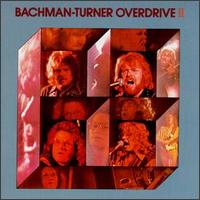 Bachman-Turner
II (Dec. 1973),
*1/2
Bachman-Turner
II (Dec. 1973),
*1/2
Ugh,
what a mess.
This is sloggy hard rock. With the shortest song clocking in
at
just under 4 minutes, there is plenty of time for either the same
damn riffs over and over again or Randy to make boring solo
runs.
The result is a mess of uninteresting guitars (the atonal, overblown
ending of "Stonegates"). Most songs are filler, using
the same formula over and over again, with the low point being the
scarred lyrics of "Tramp". The light Caribbean
"Welcome Home" is better, thanks to the jazz solo tacked on
at the end, but still too repetitive to be good. The only
saving graces here are "Let It Ride" with its background
vocals, little soloing and rhythm guitar, and the classic "Takin'
Care of Business" with its tasteful piano part and sing-along
chorus. Otherwise the album would be complete crap.
Produced by Randy Bachman. Band is Randy Bachman (guitar,
vocals), Tim Bachman (guitar, vocals), Rob Bachman (drums), C.F.
Turner (bass, vocals).
Bachman-Turner
Overdrive: Not
Fragile (Aug.
1974),
**
After
the success of
their previous album, the group improved for Not
Fragile,
although not by much. The songwriting is better, although
there
are still some obnoxious self-lauding songs ("Rock Is My Life
and This Is My Song"). The riff usage has also improved,
but still not entirely under control, as shown by "Sledgehammer"
or the title track. Randy's soloing is better, even though
his
crazy solo in "Second Hand" is marred by the annoying
persistent riff underneath. Blair Thornton, who replaces
Brother Tim, contributes a couple of decent Southern Rock knockoff
tunes. Turner's "Roll on Down The Highway" is
obviously a tribute to the majority of BTO's audience - truck
drivers. But the best song by far is Brother Randy's "You
Ain't Seen Nothing Yet", which uses the same formula as their
previous hits - a light guitar underneath, good soloing on top and a
catchy chorus. But the rest of the album pales next to that
song. An overall improvement, but still
unspectacular.
Produced by Randy Bachman.
The
Band
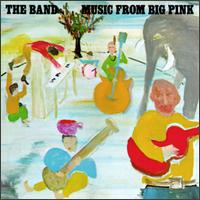 Music
From Big Pink (Jul.
1968),
****1/2
Music
From Big Pink (Jul.
1968),
****1/2
If
you go out to the Midwest or the Plains States, you'll find smaller
communities whose downtown centers are a dusty, well-worn preserve.
You won't find a big-box store there, and maybe they built a highway
outside of town, stranding the old methods of life. The Band,
formerly Bob Dylan's backing group, and formerly Ronnie Hawkins' as
well, had been around since the start of rock and roll, and their
debut was bridge between the contemporary bluesy, singer-songwriter
work of Dylan and old-time sounds. Music from Big Pink is roots-rock;
a musical retreat. But while the Grateful Dead explored Americana
with an emphasis on extended passages and had a user's countenance,
the Band were succinct and lyrically elliptical. Music from Big Pink
rarely has solos, the playing is deceptively basic and the band
members don't overshadow each other.
Certainly
their connection with Dylan helped them gain notoriety, but Music
from Big Pink is a deliberate and well-rehearsed rejection of
contemporary music trends. Five men, dressed in a manner reminiscent
of the Cripple Creek miners they allude to on "The Weight".
Or so it seems, while some psychedelia does leak into the album ("In
a Station" is a bit tripped-out), and the organ intro to "Chest
Fever" has oddly classical intro leading into a get-down beat.
Dylan's own writes (the prison hymn "I Shall Be Released")
or his co-writes ("Tears of Rage", "This Wheel's on
Fire") are not so different from the excellent indigenous
material. Guitarist Robertson wrote most of the material ("To
Kingdom Come", "Caledonia Mission", "The Weight",
"Chest Fever"), while Manuel's is more varied ("We Can
Talk", the annoying "Lonesome Susie" or the
aforementioned "In a Station"). You can bang out the songs
on here yourself, and they have a real populist tinge to it:
R&B,
gospel and country all appear in one guise or another. The
un-Hendrix, the Band may have been the most imaginative bar band in
the world. Thoughtful music for the roadhouse crowd.
The
Beau Brummels
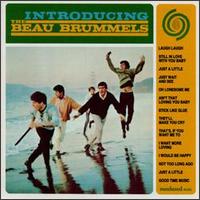 Introducing
the Beau Brummels (Apr.
1965),
***1/2
Introducing
the Beau Brummels (Apr.
1965),
***1/2
The
Beau Brummels have achieved the status of "great band that never
was" for those who are overly interested in mid-60s rock.
In truth, they were never that great, nor all that successful,
outside of two hit singles right off the bat. You see, in
1964
with America's shores being invaded by hoards of innocuous subjects
of Her Majesty the Queen wearing matching suits and the like, America
needed to strike back. Following an adage no doubt derived
from
some moralistic cartoon (at least that's how I
learn) America decided that if they couldn't beat
them,
they would join
them.
Word was sent out from the White House, and the Beau Brummels were
charged with the task of infiltrating American shores, disguised
as a British rock group.
They would then save teenage girls' hearts from being stolen,
harvested and sold on the London black market. Now you know
the
real
reason the Kinks couldn't tour the U.S. for several years.
Seriously,
the Beau Brummels are infamous as being one of America's first
cognizant answers to the British Invasion, even if was mostly trying
to be just like the Invasion. Even the Rolling Stones still
dressed nicely at this point, but these guys wanted to slot in
somewhere between the Beatles and the Zombies,
with a great debt owned to the former. Their two hit singles,
"Laugh Laugh" and "Just a Little" are the peak of
faux-British harmony rock. Both tracks do an excellent job of
echoing "And I Love Her" era Beatles with alternating leads
on crisp electric or acoustic guitars, tight harmonies, sorrow-filled
vocals and minor keys. At the same time, the Brummels distinguish
themselves by sometimes employing the reverb-saturated guitar tones
associated more with crazed surfers like Dick Dale. Yet,
guitar
chord sequences such as those on "I Want More Loving" would
be a staple of the Zombies sound for the next few years. The
album displays all the hallmark of its era - some Everly Brothers
harmonies ("I Want More Loving"), a fun throwback twist
number ("That's If You Want Me To") reminiscent of the
Beatles' cover of "Twist and Shout." There are some
flaws - "Stick Like Glue" is downright annoying, and the
vocals on ("They'll Make You Cry") sound like a drunken
impression of a Liverpudlian accent (likely not the voice of lead
vocalist Sal Valentino). Somewhere in there you can hear the
underpinnings of folk-rock, and they do cover both a country song
("Oh, Lonesome Me"), and a clean-cut version of "Ain't
That Lovin' You Baby." Still, those are the only covers on
here - as guitarist Ron Elliot shows himself to be a master of all
these forms, at a time when this wasn't expected. Plus, their
British Invasion copying really is impressive, down to the trick of
ending with two beats and different chord, and the rhythm
harmonica.
In the long run, this does date the music, so it really sounds like
1965, if not 1964 or before. There's something American about them
though - maybe that country track is belted a little too well, and
the ballads have more of the loping gate of an American country and
western.
All
in all,
it's mostly a imitation, rather than the significant advancement
which would come with the Byrds, but it is impressive enough to have
plenty of merit. I'm sure who produced the album, but at
least
"Laugh Laugh" was produced by Sly Stone (still going by Sly
Stewart at this point). The band is Ron Elliot (guitar), Sal
Valentino (vocals), Ron Meagher (bass), Declan Mulligan (guitar), and
John Peterson (drums).
I
have
their third album, Beau Brummels '66, which is all covers.
Thank the dunderheads at Warner Brothers Records for that
idea.
They then ventured off into country-rock a little earlier than most,
without success.
Black
Sabbath
 Black
Sabbath (Feb.
1970),
**
Black
Sabbath (Feb.
1970),
**
If
music were a soap
opera, Sabbath would be the drugged out, Satanic younger sibling of
Led Zeppelin. Regretfully, this is not the case, so this is
just an unfocused rip-off of Zep. Sabbath might have stolen
the
riffs, but that's all they got, or at least that's all they
use.
Ozzy's lyrics are mystical and slightly clunky, but nothing special
outside of subject matter. The band relies on Iommi a lot,
and
he winds up playing and playing, without going anywhere.
Everything sounds the same, with the exception of "N.I.B.",
which is a Cream (vs. Zep)
ripoff with
Satanic lyrics. If I was forced to pick one song to listen to
it would be the slightly amusing "The Wizard" with Ozzy's
embarrassing harmonica playing. I wonder if he would have
used
it if Robert Plant hadn't. Band is Tony Iommi (guitar),
Geezer
Butler (bass), Bill Ward (drums) and "Ossie" Osborne
(vocals). That's how it's spelled on the back cover - Ossie.
Produced by Roger Bain.
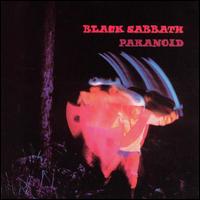
Paranoid
(Sep. 1970),
***1/2
This
album gives
Black Sabbath an identity, in addition to/place of a bad
reputation.
While Zeppelin was in many ways a traditional blues band taken to new
levels (New Yardbirds, anyone?) and still dealing with the same
issues of "lost my woman," Sabbath came from a mixed
background. They combined the pessimism and regret of the
blues
with an awareness of the world around them, seen in the lyrics
dealing with atomic holocaust, drug overdoses and the like.
It
is not fair or accurate to say that they were simply an offshoot of
Jethro Tull, but it is true that Sabbath's music came from the same
place, and simply went to a logical extreme (the bridge in "Electric
Funeral", or the entertaining "Fairies Wear Boots"
demonstrate this style). Hand in hand with these lyrics went
the gloomy leaden guitar of Iommi and the wailing of Osbourne -
combining to make Paranoid
a view of the world that's found in all aspects of the album.
Even the quietest track (the fascinating "Planet Caravan"
with Iommi demonstrating that yes, he can play in a jazzy way) seems
like a post-apocalyptic moment - all too-quiet compared to the rest
of the album. Of course, it goes without saying that this
album
is far better than their self-titled debut, but still has
flaws.
The group seems more focused, playing clearly delineated songs
as
opposed to the ramshackle nature of some of their earlier
work.
Iommi also shifts away from playing and playing and lets his eerie
doom riffs do the talking. Granted, that does lead to some
dead
time where you expect a solo to crop up ("War Pigs"), but
on the whole it's as effective as the riffs are. And, for the
most part, the riffs are successful - after all, this album does
contain what is one of the best riffs of all time ("Iron Man"
which is probably their most well-known song), even though there are
some relatively ineffectual ones (the repeating 4-bars of the title
track). The lyrics (Ozzy's?) also are vastly improved ("Hand
of Doom" which refers to drug use as "giving death a kiss"
for example), and the vocals and guitar pretty much trade off being
in front. The album also benefits from some real production,
with Ozzy's voice receiving various treatments, and even the sounds
of an air raid siren pop up in the opening seconds. But, the
dead space does add up and things like drum solos ("Rat Salad")
and hokey production tricks to end songs ("War Pigs") don't
help. An entertaining classic, but a flawed one.
Produced
by Bain again.
The
Blossom Toes
 Blossom
Toes: We Are
Ever So Clean (Nov.
1967),
****
Blossom
Toes: We Are
Ever So Clean (Nov.
1967),
****
I
finally deliver on my aim of obscure artists. This album is
orchestral rock, if the Moody Blues trying to imitate the
Beatles.
It may be derivative as hell, but it is well written and tons of
fun. There's lots of lush Moodys-style vocal harmonies ("Look
at Me I'm You"), and tasteful orchestration ("Mr.
Watchmaker", "Love Is"), but no organization along the
lines of Days
of Future Passed.
Not to mention the Beatles-esque trumpet runs, and Ringo-ish drumming
which pop up occasionally. The songs aren't love ballads, but
more British whimsy, with a few almost Kinks-like
numbers here and there ("People of the Royal Parks").
The band does have an ear for interesting chord changes occasionally
("I'll Be Late for Tea"), but nothing striking. That
is, with one huge exception, "The Remarkable Saga of the Frozen
Dog" which has broken backup vocals and a droning sound to it,
set over the usual nonsense lyrics that mark the period. (The
band were Beefheart fans, if that tells you something). Otherwise the
album is fun, light, and guaranteed to delight. The only
problem will be finding a copy, as the original didn't sell well, and
the CD is way out of print. If you decide to assemble it
yourself, don't forget to include their even rarer single that came
after this, the amusing "Postcard/Everyone's Leaving Me Know"
which appears on the real CD. Of course, the CD used that
single to replace two other tracks "The Intrepid Baloonists'
Handbook Vol. 1" and "Track for Speed Freaks", which
is one of those album condensed into brief period of time
tracks.
Band is Kevin Westlake (drums), Brian Belshaw (bass), Jim Cregan
(guitar) and Brian Godding (guitar). Cregan later showed in
Family, and then as a Rod Stewart sideman. Produced by Giorgio Gomelsky.
The group released a hard rock album two years
later (If
Only for a Moment),
becoming one of the first bands with twin lead guitarists.
From
what I've heard it is nowhere as interesting.
Blues
Image

Blues
Image (1969),
**
Ah
- journeymen, those musicians who pass from one group to another
without any real stability. In some ways they are a step above
session-men because they are actually members of a group, but they
may not have the security or the success of a session life. On this
album we have future examples of both. This album itself is well
performed, well produced and fairly boring blues-rock. Well, it's not
entirely blues rock - the liner notes claim that Latin Rock is "their
own development." Santana's snub aside, the Latin influence is
fairly weak. There's a couple of tracks that have touches and some
lyrics in Spanish ("Outside Was Night" and "Yesterday
Could Be Today") but mainly the claim appears to be grounded in
the fact that they have a dedicated percussionist, future session man
Joe Lala. Guitarist (and future journeyman) Mike Pinera has a good
grasp of various blues styles (he'll play loud, he'll play soft,
he'll play hard), but his vocals are admittedly vanilla. Lala sings
on the album's only two decent tracks ("Take Me to the Sunrise"
and "Leaving My Troubles Behind" conveniently placed as the
first and second tracks on the album), so you have to wonder why he
didn't get more leads. Like I said before, it's not badly performed,
just really uninspired stuff (the slow traditional "Lazy Day
Blues") or with fairly bad lyrics (the chorus of "In Front
Behind You" contains the line "a whisper in a broken dream
cannot be heard at all"). Lots of skills and potential, but not
a whole lot else. Later on they scored a Top 10 hit with "Ride
Captain Ride", a good song, and one that is not on this album.
Pinera left soon afterwards to join Iron Butterfly and begin his
wandering days with middle-road bands. Lala became a top session
percussionist after the group broke up the next year. This album has
not been re-released on CD, and there's absolutely no reason to track
it down on vinyl. Produced by Bill Halverson.
The
Blues Magoos
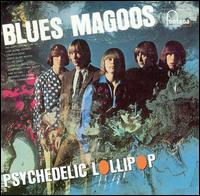 Blues
Magoos: Psychedelic
Lollipop
(Nov. 1966), ****
Blues
Magoos: Psychedelic
Lollipop
(Nov. 1966), ****
A
prime piece of 1966, consisting of pretty hard R&B. The band
had
too much talent and structure to be a real garage band, and both lead
guitarist Mike Esposito and drummer Geoff Daking were
excellent.
Ralph Scala's puny organ and minor chords made them sound like the
Animals in their prime ("Sometimes I Think About", "Love
Seems Doomed" to a lesser extent) even though Ralph's vocals
were not as emotive as Eric Burdon's. While they don't reach the
level of the Who, they are
heavy enough
("Gotta Get Away", "She's Coming Home"), and
could have nicely slotted into Pete Townshend's coined "power-pop"
(the fun "One by One"). Of course, the big-deal track is
the Top-10 hit "(We Ain't Got) Nothin' Yet" which has all
of the attitude and grittiness of garage rock, but with tighter
playing. It's pretty early to be as psychedelic as the cover and
title may suggest, and this is more like what the English would call
"freakbeat" but with some Indian drones as well. They may
not be the Who, but Esposito has his share of cutting-edge guitar
moments, culminating in a fantastic cover of "Tobacco Road"
where he leads the band to a destructive break-down with guitar
launched feedback, until the entire band is pretty much just making
noise in rhythm. Most of the band's material is
original
which is impressive, and it's really only on the covers that they
waste time (the folky ballad "Queen of My Nights", James
Brown's "I'll Go Crazy", "Worried Life Blues").
Clearly a strong American response to the British Invasion, pointing
towards the harder sounds which would come out of Detroit a few years
later. The rest of the band is Emil "Peppy" Thielheim
(guitar) and Ron Gilbert (bass). Produced by Bob
Wyld and
Art Polhemus.
Bodine
 Bodine
(1969),
***
Bodine
(1969),
***
Hey
kids, ever heard of this album? I thought not. With so much
garbage on CD, the fact that this album has not been re-released is a
shame. Bodine were a bunch of no-names with skill, but after
this album I can't find record of the members doing much. As
for this album, it is a good mix of rock, scratchy guitars,
country-rock and songwriting talent. The most obvious
comparison is Buffalo Springfield, but I've never been able to find
their records. That being said, there's only about half an
excellent album on here, but man it's a great half. For
example, their take on country-rock is pretty good, with the opener
"Short-Time Woman" chugging along with strong rhythm
guitars. In fact, one thing I can say about this group is
that
they can lay down a monster beat sometimes. Just listen to
"Easy to See", which has to be the best song on here.
It just draws you in, and you feel the fun they had in the
studio.
Otherwise, there are some fine attempts at regular rock ("Into
My Life", and the 60s epitaph "Oakland"). "It's
Just My Way" is a decent acoustic ballad (with a ridiculous
organ solo), and goes on a bit long, but still merits
mention.
The back side is less strong, with only "Keep Lookin Through
Your Window" and its awesome bass line standing out. They
even go so far as to do one of those Dylan-impersonation songs
("Disaster"), but it avoids living up to its name.
Most of the songs were written by guitarists Steve Lalor and Eric
Karl, but you wouldn't know that looking at the album. The
group declined to give their last names on the inside photos, as well
as which instruments they played. Bassist Kerry Magness used
to
be in the Kingsmen (y'know "Louie, Louie", but not original
lineup) and did session work for the Doors. The other members
of were David Brooks on keys (largely superfluous) and Jon Keliehor
on drums (partially responsible for the monster beat).
Produced
by Bill Cowsill, Jr. (of the Cowsills for pete's sake.) For
where I got my info go to http://theregents.net/bodine.html.
John
Keliehor wrote me
an email about Bodine, which is a
bona-fide feature.
Catapilla
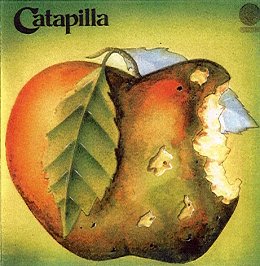 Catapilla
(1971), ***1/2
Catapilla
(1971), ***1/2
What
if there was an alternate universe with an evil
jazz-rock band? Well, Catapilla's not evil per
se,
just really, really dark. To construct this Catapilla take a
rhythm section (including guitar) which could have come out of the
Blues Revival of the late 60s, some jazz-blowing horns with
Third/Fourth
style arrangements, brooding lyrics, and the most out-to-lunch female
vocalist ever, Anna Meek. There are many alternate theories
that can be constructed to explain Meek's singing, but I'll venture
only a few of them. Most of the time she has an odd accent
that
sounds either Scandinavian, aristocratic English, or Grace
Slick with her vocal passages unnaturally widened. Meek is
over-the-top and then some - she screams, she coos, she's usually
off-key - all within the same song ("Promises"). She sounds
like some hammy horror villain who would say "I've gone mad,
mad, mad, mad!" with a cackle. I could learn that she was
violently insane and not be surprised. She might be the female Ozzy,
but he sounds better. All in all, this recipe makes a very
odd
combination, but fortunately there's plenty of instrumental
sections. The opening track, "Naked Death" has a lot
of laid back sax lines (and wah-wah horns?!) and a generally creepy
feeling otherwise. Then comes "Tumble Weed" which is
very traditional sounding, both in horn usage and lyrics, and
subsequently falls flat on it's face. It's followed by
"Promises" which is sort of a traditional horn rock/Third
hybrid with Meek showing her full range of whatever it is she has a
full range of. The real kicker (and jewel of the album) is
the
whole back side, given over to "Embryonic Fusion", which
alternates the straightforward jazz playing of the horns with Meek's
creepy vocals and guitar based jazz-rock, all the while doing nice
time signatures like 14/8. Canterbury on dangerous
destabilizing drugs? Atmospheric at the least, it's both
creepy
and cool. Produced by future Black
Sabbath
manager/producer Patrick Meehan, Jr. The only band members of
historical note are Robert Calvert (sax) who may or may not be the
one associated with Hawkwind, and Dave Taylor (bass) who seems to
have become a longtime member of Bryan Adams' backing band.
Alice
Cooper
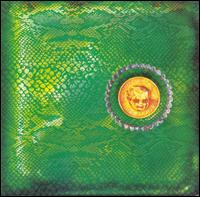 Billion
Dollar Babies (Mar.
1973),
****
Billion
Dollar Babies (Mar.
1973),
****
With
his elaborate stage shows Alice Cooper may be the closest thing
America had to glam-rock. There are substantial differences
of
course, as Cooper focused on the sadistic, shocking parts of life on
stage and in his music. I really mean "on stage"
because Cooper was foremost an excellent showman, which shows up on
the first track here ("Hello Hooray") where you can almost
feel him building off an audience. But behind it all was
excellent songwriting, playing and vocals. David Bowie
crossed
with Screaming Lord Sutch? Something like that anyway,
especially with call to be elected ("Election").
Don't be fooled by his appearance - Cooper was based much more in
melodic 60s power-pop (the la-la choruses and the hit "No More
Mister Nice Guy" are the best examples) than heavy metal,
although he drew from that also. Of course, there's always
the
possibility for musical plagiarism, which happens in the socially
indicting "Generation Landslide" which manages to borrow
from the opening of "Dear Prudence" as well as Tommy.
But the hard-hitting metal style works well with Cooper's shock
approach such as on the creepy, riffy title track (with Donovan on
co-lead vocals) or the dragging "Sick Things", but
strangely not on "Raped and Freezing" which is such a good
time you hardly notice the subject matter. However,
sometimes his attempts to shock simply don't have much value, as on
"Unfinished Sweet" a song which seems to be an excuse to
use a dentist's drill and the James Bond theme, or an overblown
tribute to necrophilia ("I Love the Dead"), complete with
fast breathing noises. But overall the musicians here are
excellent, while Cooper changes his vocal style almost track to
track; from a nasally rasp, to open-throated yelling, to a "normal"
voice for the simple piano ballad "Mary-Ann" (which seems
out of place until you think about the lyrics). The end
result
is an album which is a much more than a teenager's tool for
rebellion. Produced by Bob Ezrin.
Curved
Air
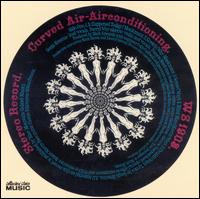 Air
Conditioning (Nov.
1970),
**1/2
Air
Conditioning (Nov.
1970),
**1/2
Strange
days indeed, when this album made number eight on the British charts.
Or maybe not--why not take two of the more popular musical strands
and combine them? Procol Harum
may
have been a blues band with classical interpolations, but Air
Conditioning is
an odd alliance of roaringly distorted rock guitar and classically
inclined prog-rock. Francis Monkman's guitar is uses almost entirely
for dirty, dirty blues leads, often played off of Darryl Way's
classically tilted violin. Monkman has both sides covered actually;
he was a classically trained pianist, and his songs and frequent
keyboards are more staid. But even if you were not listening to
Monkman's squalling guitar, you probably would notice Sonja Kristina,
one of the few female vocalists in prog-rock (or even rock).
Kristina's singing is more calculated than natural ("Hide and
Seek"), possibly because her voice is better at lower
intensities. The band's unique approach has some strange results. For
example, the bluesy "Stretch" sounds like a contemporary
Jefferson Airplane
track with male and
female vocals, violin and crapped out guitar. Even more unusual are
the hushed vocals, acoustic guitar and simple percussion on "Blind
Man", eerily foreshadowing Suzanne Vega! It is not quite Rick
Wakeman meets Peter
Kaukonen, and
the "let's please everyone" integration approach of rocking
guitar and classical causes is not always smooth--the album's opener,
"It Happened Today" opens with Monkman splaying blues lines
over pounding proud piano and Kristina's imprecisely double-tracked
falsetto (hitting you with two crests), before abruptly shifting into
a slower, Way-led section. The album has a more serious, darker tinge
to it, thanks to the instrumentation, and their operating in the
realm of bombast ("Vivaldi"), classical/folk (the
dispirited "Situations", "Screw"), and blues
("Hide and Seek"). On top of everything and the band also
had an experimental streak, (the name was derived from Terry Riley's
A
Rainbow in Curved Air,
after all) with Way's Four
Seasons
synthesis mutating into something that sounds like a strange
synthesized noise, which turns out to be a distorted violin. The less
than satisfying production also has some odd twists like non-synced
vocals ("It Happened Today") or guitars ("Proposition"),
in an nod to Riley's experimentation with overdubbing. Still, Air
Conditioning
is more a process of discovery than playing to the group's strengths.
Monkman's blown-out blues trend is nowhere near as compelling as
Way's violin work on "Vivaldi" or "Vivaldi with
Cannons". Only on one track do they realize their full
potential: the stately "Screw" which has a great hook (oft
repeated) and where Monkman's guitar slowly burns as a counterpoint.
Otherwise, Air
Conditioning is
more about the journey than what you find at the end, placing it
closer to American bands such as Sweetwater and the Jefferson
Airplane than their British contemporaries.
Dire
Straits
 Dire
Straits (May
1978),
***1/2
Dire
Straits (May
1978),
***1/2
"It
ain't what they call rock and roll" - a line in Dire Straits'
big hit "Sultans of Swing" which sums up the band's
approach to music. Not that guitarist/singer/writer/leader Mark
Knopfler was saying that it isn't rock and roll - just that
it's
not what's in vogue with the young kids. This is the
Counter-Reformation to the young revolution of the Clash,
the Sex Pistols and everyone else. Knopfler hearkens back to
the
clean, cool blues of the 70s (think Eric Clapton),
but employs all the modern trappings of New Wave. This goes along
with his songs of broken or lost love - you won't find any
society-directed anger or frustration. The rhythm section of 2nd
guitar (Mark's brother David), bass (John Illsley) and drums (Pick
Withers) is trim, nimble, and remarkably consistent - just
what
you'd expect in the New Wave era. But here, all that lack of sound
only emphasizes the punctuation that Knopfler's guitar makes
when he solos. And it does punctuate - Knopfler is rather
fleet-fingered, and has his own distinct style right from the
start, mixing blues with the older country forms, and shades of jazz
thrown in. Not surprising then, that "Sultans of
Swing" is about a Dixieland band who gets no respect.
However,
it's not terribly authentic. Knopfler was in his late twenties, yet
his singing makes him sound like he's 40 at least. He either
sings like he's making off-handed comments, or just growls his way
through (the generally creepy "Six Blade Knife"). The
band tweaks it's clean blues formula just enough throughout to
prevent it from being boring, but there's still a few
instances
of Didn't
I Just Hear This Song?
(recycling the 50s electric country-blues feel of "Setting Me
Up" all of two tracks later in "Southbound Again").
The few attempts with acoustic instruments ("Water of Love")
aren't enough to offset this. The band is so low-key that they
drift towards Adult Contemporary ("Wild West End") or
soft-core pornographic soundtracks ("Lions"). The faster
and more energetic the performance ("Sultans of Swing",
"Down to the Waterline"), the more successful.
Is
it New Wave then? Or a Counter-Reformation? I'd think its influences
are too recent to be New Wave, and it's contemporary enough
with
Punk and New Wave to be a real Counter-Reformation. Mark
Knopfler started out in the same pub rock bands that punk grew
out of - he just went in a different direction. Produced by Muff
Winwood - and yes, he's Stevie's brother.
Dust
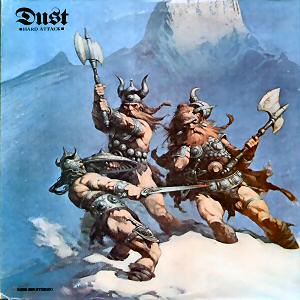 Hard
Attack (1972), ***
Hard
Attack (1972), ***
Where
the American metal bands were in the early 70s has always been a
mystery to me. The Detroit scene was in the process of fizzling, and
outside of that I'm hard pressed to name another American group that
would
qualify as early metal outside of Blue Oyster Cult (but that's
another story). So are Dust an early metal band? Well, I
haven't heard their debut from the year before, but according to
this, occasionally yes. Guitarist Richie Wise clearly has
drawn
his inspiration from the loud English blues groups of the late 60s,
but he hasn't evolved much, still firing off snappy little blues
lines here and there on his cranked-up guitar like it's 1969
("Ivory"). But the group's sound is also grounded in
country/folk, and Wise uses a fair amount of acoustic guitar both on
the harder-edged songs (most visible on the mildly schizophrenic
"Pull Away/So Many Times") and in a couple of down-home
songs. It's a bit odd to hear an angry breakup song with
loads
of slide guitar ("How Many Horses") right next to a
thunderous tune along the same lines but with darker lyrics
("Suicide"). Lyricist Kenny Kerner must have been
hanging with Keith Reid on that pre-Home
bender,
as they lyrics here are either on along these post-breakup or suicide
contemplation lines, the latter sometimes paired ironically with the
music ("I Been Thinkin'" is a poetic ode to the latter).
This comes out in "Thusly Spoken" which sounds like a
pairing of a Procol Harum
tune with
the scale of Bowie's "Oh You Pretty Things" as Richie
casually describes the apocalypse over strings and gentle
piano.
The fantastic rhythm section consists of Kenny Aaronson, who pulls
plenty of weight on bass and slide guitar, and Marc Bell (the future
Marky Ramone) who's driving style is only made absurd by the fact
that he was about 16 years old when this was recorded! This
album's problem is that while the group has a fairly diverse sound,
Wise is not that good a guitar player, and the band's material isn't
too distinct. Take "Ivory" for instance - a great
track which finds the band engaged in the titular hard attack, but
Wise isn't able to go anywhere beyond his rather ordinary line, where
there's plenty of room for him to solo. This is what makes
them
seem more like a really loud depressed rock group at times (the great
"All in All" with plenty of who-like power chords, "Walk
in the Soft Rain"). Still, this is an interesting album to
listen to, if not essential. Kerner and Wise produced, and
they
later did that as a team after the group's breakup (the Stories
which Aaronson joined, and Kiss).
Earth
Opera
 Earth Opera
(1968),
***
Earth Opera
(1968),
***
Earth
Opera
is curious, as it raised havoc with my expectations.
A name which suggests grandiose designs, intriguing cover
art,
and future Seatrain gentleman Peter
Rowan, who wrote most of the
album and handles lead vocals. Surprising therefore, to find
that
Earth Opera was a low-key, stately folk rock band, the sort of thing
appealing to the artier crowd of 1967. Much of this is due to
hushed nature of the music, relying on David Grisman's
mandolin/mandocello and their keyboardist/vibraphonist Bill Stevenson.
Above this stands Rowan with his declamatory vocals, as if he
had
learned elocution from recordings of T. S. Eliot. He wrote
almost
all of the album, and his lyrics were what might
pass for poetry at the time, with empty statements ("As It Is Before")
along with good phrasing and observation ("The Child Bride", "The Red
Sox are Winning", "When You Were Full of Wonder"). "The Red
Sox
are Winning" is the album's attempt at a pop song, with Rowan's offhand
commentary (and moan), a nice vibraphone solo, and dixieland
references. For the most part it's very
pleasant ("Dreamless" merges jug-band music with the
harpsichord
rock so in vogue) and gentle "The Child Bride", "Close Your Eyes",
"When You Were Full of Wonder"). The band rarely turns up the
volume, ("Time and Again" is really the exception), and except for a
blip on "Home of the Brave", Rowan remains unruffled. The
only
mistakes are ones of scope, as their sound was not well suited to
longer songs "As It Is Before" drifts onward seemingly forever, and
"Death by Fire" (likely their attempt at an epic commentary on
religion) also stumbles in Purgatory for an eternity. Still,
a
nice band, with a distinctive sound. The band recorded a
second
LP, The
Great American Eagle Tragedy
without Stevenson before splitting. The rest of the band was
John
Nagy (bass), with Billy Mundi and Warren Smith filling in on drums for
new member Paul Dillon.
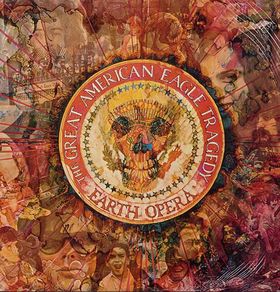 The Great American Eagle Tragedy
(1969), ***1/2
The Great American Eagle Tragedy
(1969), ***1/2
Earth
Opera's second, final album is really solid. While their
debut
often stalled, or lightly lingered while Rowan explained things, a
few seconds of the warmly encompassing "Home to You" shows an
engaging band. The
Great American Eagle Tragedy
is lively, and sounds great. Rowan dropped the
haughty vocals
for real singing, and plenty of guys fill in the sound:
saxophonists, keyboardists, even John Cale. (Wise move,
as none of the band comes across as a strong
soloist). The albums best tracks show some folk
lineage:
light country-rock in the opening "Home to You" - which could have been
a hit, or the tragic old-world folk song "Mad Lydia's Waltz". As before, their
musical tastes are fairly diffuse, showing poppier
rock ("Roast Beef Love") or old school rock and roll with jazz
flourishes on "Sanctuary from the Law"). The album still has
some
longer works, but nothing like the time-suck that was Earth Opera's
"Death by Fire". In fact, both are good and plenty jazzy: the
slowly building, poetic "All Winter Long" which closes out the A-side,
and then the title track - political commentary couched as fable.
The latter stops and starts, opening with a mournful trio of
saxophones then alternating between slower, more intimate versus and
buzzed-up choruses. But no matter the track, this band had
that
mysterious "it" - a good sound with strong bass, well-thought out songs
and arrangements. You even want to listen again to the lesser
tracks (Dillon's poppy "Alfie Finney", some
blues on "It's Love") which sound good, even if they are not going to
win showcase awards. So, a very good album, with some weak
spots
(or long spots) and a couple of above-average filler tracks, but with a
great sound. Produced by Peter K. Siegel.
Rowan
went on to the Americana melting pot of Seatrain, Grisman
played with people like Jerry Garcia, and Nagy went into session work.
The
Electric Flag
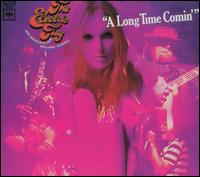 "A
Long Time Comin'"
(1968),
**
"A
Long Time Comin'"
(1968),
**
Guitarist
Michael Bloomfield's liner notes proclaim the Electric Flag to be "an
American Music Band," and then lists the various forms of
"American Music." He neglects to mention that the
band manages to drain every last one of them of
entertainment.
But the music is a poor counterpart to Blood, Sweat and Tears' Child
Is Father to the Man
-
blues, soul and pop, plus a horn section. The musicians are
professionals, but most of the time they sound like a generic Motown
backing band. It didn't have to end up this way - Bloomfield was a
talented blues guitarist formerly with the Butterfield Blues Band,
and his companions also were of some note. However,
Bloomfield
is the band's only stand-out soloist, and he's limited to the blues
("Killing Floor", "Texas"). Drummer Buddy
Miles manages to blow his vocals on the soul songs (which might as
well have been labeled soul
in big letters next to them) and kills the promising "Over-Lovin'
You" and "You Don't Realize". The band's sound
is so big it's hard to find a place for everyone, and organist Barry
Goldberg as well as the horn section never really stand out.
The album also isn't helped by dated psychedelic tape effects
("Another Country"), or wretched mixing decisions
("Groovin' Is Easy" or "She Should Have Just"
which bury most of the band in the center). Plus the Flag's
songwriting is shockingly weak. Vocalist Nick Gravenities was
a
songwriter, but strangely does not contribute anything here.
Instead, the band plays a trio of horribly dated pop duds by
Quicksilver Messenger Service's manager Ron Polte including
("Groovin' Is Easy") matched by their own in-house stinker
(Goldberg's "Sittin' In Circles"). The only
completely likable song is a swinging boogie-woogie arrangement of
"Wine". Botched on all levels at various points.
Produced by John Court. The CD version includes the non-LP
single "Sunny"/"Mystery" with the A-side being a
cover of a song I disliked to begin with. It also has a
couple
of unreleased tracks for those who can't get enough (masochists).
You
can thank the
public library for this one.
Elephant's
Memory
 Elephant's
Memory: Take It
to the Streets (1971),
****1/2
Elephant's
Memory: Take It
to the Streets (1971),
****1/2
New York had
its fair share of bands, but because the city was (and still is) so
diverse it's hard to say that there was a distinct New York sound
(outside of the 60s folk circuit), unlike places like Detroit or San
Francisco. Take
It to the Streets reflects
this, as the band demonstrates skill with a multitude of
styles.
But instead of mixing them together, the band tends to shift between
genres mid-song, and as a result there's little emphasis on
soloing.
So what does Elephant's Memory sound like? Like a crazed rock
band with auxiliary horns (Myron Yules on trombone and lead vocalist
Stan Bronstein on saxophone) and left-wing pro-revolution
lyrics.
The opening track and supposed hit single "Mongoose" is a
good example. One of their more conventionally structured songs, it
sounds like a rough-and-tumble Chicago
-
African rhythms, gravely lead vocals, horns and a catchy
chorus.
But the very next song, "Power", showcases their radical
political views with a primitive fast paced Detroit-sounding song
driven by Rick Frank's 1-2 drumming and shouts of "hey"
(you can almost hear the fists being pumped in the air). The
middle section turns into a trade off between two people shouting
revolutionary advice before the horns completely change the tone of
the song by entering mariachi style, without a change in the the
beat. But hand in hand with their protest lyrics is a good
sense of humor, seen in lines like ("Rip up the judge / rip up
the mail") or tracks like pianist Myron Yules' "I Couldn't
Dream" which is a catchy parody of overly serious hipster jazz,
right down to the nonsensical lyrics. The rest of the album
is
at complete odds any attempt to simply think of them as "rock-jazz,"
because it is mostly angry left-wing country rock. But it's
cleverly done - "She's Just Naturally Bad" is a trashy
delight with a women sing-along line in the chorus ("I'm just
naturally bad," of course). Another example is "Piece
Now", where Detroit meets San Francisco in terms of sound, but
the song is constructed with a counterpoint. Or what do you
do
with "Damn", where the Beatles-country-rock ends, only to
be followed by a Memphis Soul horn section that gets prolonged in
hilarious fashion? The album is fascinating and smart, with
only one track that doesn't quite match the rest ("Ivan"
another country rock tune). The band is Stan Bronstein (lead
vocals, tenor sax), Myron Yules (trombone, piano), Rick Frank
credited as Reek Havoc (drums), John Ward (bass), David Cohen
(guitar, keyboards), Guy Peritore (guitar) and Mike Rose
(guitar).
Bronstein and Frank are the only consistent ones credited with
writing the songs (along with other members). No, I have no
idea which guitarist does what. Produced by Ted Cooper.
Oh,
these
guys were fairly well known back in the day. Some of the
music
was on the Midnight
Cowboy
soundtrack, and John and Yoko used them for backing the next year in
NYC (that's Elephant's Memory on the live albums from that
year).
Lennon also produced the group's next album, and then Elephant's
Memory backed Chuck Berry on an album in 1973, before recording their
final album the next year.
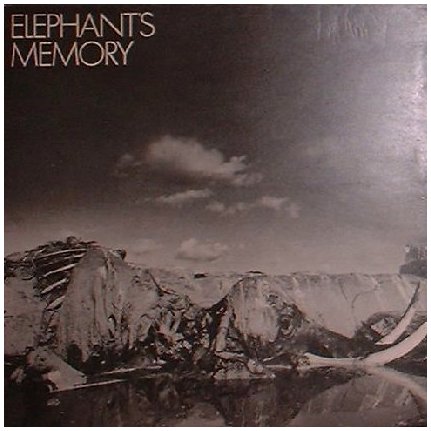 Elephant's
Memory (Sep.
1972),
**1/2
Elephant's
Memory (Sep.
1972),
**1/2
A group of
goofy left-wing radicals in the studio with John Lennon and Yoko Ono
sure sounds like a recipe for success. But, as with most of
the
Beatles' Apple label releases (excepting their solo work and
Badfinger) the result is disappointing. Most of the old
members
of Elephant's Memory were gone, with only Frank and Bronstein
remaining. They also transformed from whacko rock group with
horns to an average guitar-rock band, with country tendencies and a
saxophone. Sure, Bronstein's faintly Wolfman Jack/John Kay -
like vocals are still distinctive, but the music isn't. New
guitarist Wayne "Tex" Gabriel only distinguishes himself by
using a slide, and then not with any imagination (the sax/slide jam
in "Baddest of the Mean"). Their political stance is
still present, but toned down to be simply lyrically goofy, not
musically cool. The single "Liberation Special"
typifies this approach - fairly radical lyrics to a straightforward
rock song, and the train-whistle vocals don't add much.
There's
plenty of generic 50s revivalism to go around ("Chuck 'N Bo",
"Power Boogie", "Cryin Blacksheep Blues") and
some decent hard-rock ("Gypsy Wolf" and "Madness"),
but it lacks the humor or just plain nuttiness that made their
previous album so much fun. While the album is stylistically
consistent, the tracks written by the newer members are either bleh
(Gabriel's "Life"), or just plain terrible (bassist Gary L.
Van Scyoc's terrible "Wind Ridge" which repeats its chorus
ad
infinitum).
The album's only inspired moment is the herky-jerky "Local
Plastic Ono Band" which Bronstein makes sound like the Chiquita
banana song gone awry. Lennon contributes some innocuous
piano
and guitar in places and Ono sings, and their production just bounces
the sound around. Kind of ironic, that the teaming of a
whacko
horn-rock group with a pair of conceptual avant-gardists turned out
to be rather ordinary. The other member of the group is Adam
Ippolito (keys).
The
Free Spirits
The
Free
Spirits:  Out
of Sight and Sound (1966),
***
Out
of Sight and Sound (1966),
***
The
Free Spirits were a group of New York jazz cats making rock music,
and man, it
is hip!
This music is jazz-rock before anyone was doing it, and the band
really creates a unique sound, blending jazz instrumentation into
contemporary sounds. The people involved, tenor sax player
Jim
Pepper, guitarist Chip Baker, bassist Chris Hills, drummer Bobby
Moses and guitarist/singer Larry Coryell, were good musicians, and
most of these guys went on to bigger things (notably Larry Coryell's
solo career). When it gels, the chaotic sax lines, jazz drumming,
affected vocals make an interesting experience ("Don't Look Now
(Your Head is Turned Around)" or "Bad News Cat").
There are big glaring holes in the whole experience, though, which
scuttle the album. One is that Coryell (or is it
Baker?
who knows?) is not much of a singer, and his delivery is best
described as either consciously cool ("LBOP"), or more of
the Lou Reed spoken variety (the nice "Angels Can't Be True"
or "Blue Water Mother", where two people singing different
lyrics simultaneously on the verses). The harmonies are of
the
shouted imprecise type ("Early Mornin' Fear"), rather than
the get the notes right type. Maybe these guys were too
creative to be bothered with such details. This would not be
so
bad if the band had not focused so heavily on their antiquated
lyrics, mainly written by guitarist Chip Baker. He (and
Coryell
to some extent) tried to be clever in a Beat Poet manner which pegs
them as mid-60s (the album's opening line is something like "Take
me out a-sailing on a muddy stream of consciousness").
This decision or premise almost designates the album as a historical
item ("Cosmic Daddy Dancer", "Bad News Cat" are
among the song titles). It may have been cool, it may have
been
the scene, but it sticks out like an Edsel on the
racetrack.
Some of their music choices are dated also - "I'm Gonna Be Free"
is a sitar and flute number straight out of the background music from
Help!,
and there's some lesser folk as well ("Girl of the Mountain",
"Storm"). Coryell fans will likely come away
disappointed, as he doesn't make any real jazz solos, occasionally
producing the blues ("Cosmic Daddy Dancer" if it is not
Baker). Instead, Jim Pepper's squiggly fast tenor sax lines get all
the showtime ("Don't Look Now", "Sunday Telephone").
The band has a good sound here when they stick more with the
jazz-rock, but their lyrics and vocals prevent this album from being
more than a time capsule of mid-60s NYC, and a minor footnote in the
history of jazz-rock.
Sometimes the hep cats can be a little too
hep.
Produced by Bob Thiele.
Godfrey
Daniel
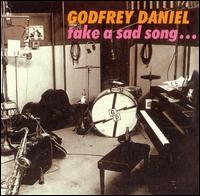 Godfrey
Daniel: Take a
Sad Song... (1972)
Godfrey
Daniel: Take a
Sad Song... (1972)
This isn't a
review, merely a heads up. Here is this album's concept -
take
a bunch of respected rock songs and record them in older styles with
hilarious results. Can you imagine a doo-wop version of "Hey
Jude" or "Whole Lotta Love"? Or how about "Hey
Jude" as done by Righteous Brothers knock-offs. How about
the Rascals' "Groovin'" done as if it was on the vaudeville
stage? Buddy Miles' "Them
Changes" as by the Glenn Miller Orchestra? The real
brilliance is the exact nature of these replicas - if they were
sloppy or done tongue-in-cheek it would have ruined
everything.
None of the perpetrators (musicians) are identified, but it was
produced by Andy Solomon and Dave Palmer (both ex-Amboy Dukes) and
endorsed by "radio station KAKA". (LP Atlantic SD
7219).
Gracious!
 Gracious!
(1970), **1/2
Gracious!
(1970), **1/2
An OK English progressive-rock band who made an OK
debut. Guitarist Alan Cowderoy uses the common loud,
distorted,
blues-based approach, while keyboardist Martin Kitcat is more about
atmosphere. The rhythm section of Robert Lipson (drums) and
Tim
Wheatley (bass) is a write-off. Wisely, the band shuffles
instrumental passages since they lack any soloist who can hold a
listener's attention for very long. This method tries to
sound
dramatic (the symphonic opening of "Heaven"), but often
there is a sense of disconnect between the segments. They are
not particularly interesting in most of them - classical, jazzy, even
easy listening. They sound pretty good only when Cowderoy
does
his bluesy thing (the hard rock of "Introduction", and
portions of "The Dream"), or the album uses guitar-based
menace ("Hell" once it gets cranked up with Kitcat using
Rare Bird-like distorted
electric piano, some
of the earlier segments in "The Dream"). Gracious!
had fairly lofty ideas/plans, but not enough talent to execute them
well.
While
their
instrumental skills don't stand out, the band's lyrics are dated to
the point of being awful. There's a concept side to the album
-
featuring an "Introduction" followed by "Heaven"
and "Hell." The side's opening sounds like the
soundtrack to a horror TV movie, with Cowderoy's threatening guitar
working with Kitcat's harpsichord, making it one of the album's
better tracks. But sure enough, vocalist Paul Davis lets us
down gently with the lyrics, starting off with a nice anachronism
like "Let your mind trip to things that we do."
The whole Heaven/Hell topic is appropriate enough for a group that
formed in a religious school, but it is all tongue in cheek.
Thus, Heaven is a boring stately place, with vocalist Paul Davis
asking if we have a clean mind, and will we be able to give money to
the church before death, in order to compensate. Hell is
supposed to sound like more fun, with Kitcat dragging out some
barrelhouse piano, but Davis crams his voice through his nose
here.
Truth be told, neither "Heaven" nor "Hell" is
much fun. (Amusingly enough, Davis later played Peter on the
Jesus Christ Superstar album.)
The
final
track, "The Dream", is where the real lyrical chestnuts
lie. It's just as slow and pompous as the rest of the album,
but the band has moments here amidst lines like "In the presence
of myself, I see a gathering of people to hear the music play /
Seated on velvet and looking / I am aware of one child / She is
turning me on." The band then pulls out a nice
section when Davis discusses this girl, with lots of echoed
atmospheric keyboards. Of course this is followed by another
classic line: "Hey you - what about that bread you owe me?"
and then a brief Hey Jude parody moment. Probably great stuff
in concert, but painful (or downright hilarious) to listen
to.
Their
saving grace? "Fugue in D Minor" which is straight
classical music led by acoustic guitar and harpsichord. Not
the
first time this was done (the intro to Renaissance's
"Wanderer" is better), but a pretty good example of
rule-following. A bit sad it is the best track on
here. So,
here's your sketch: classical and blues juxtaposed, with the
Cowderoy's blues really outshining their low-rent progressive rock
and the lyrics being outshone by everything. Produced by Hugh
Murphy.
The
group
released a second album, This Is ...Gracious!,
before
dissolving.
Greenslade
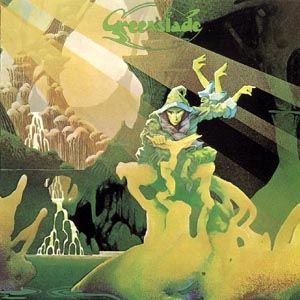 Greenslade
(1973), ***
Greenslade
(1973), ***
Back
in the day there must have been plenty of groups that attempted to
hitch their fortunes to the ascending prog-rock star.
Greenslade might fall into the category of johnny-come-latelies
playing another round of Look
at My Time Signatures,
in which case it would be proper to dismiss them outright and move
on. But Greenslade cannot be entirely overlooked for a few
reasons. First off the players, while hardly winning any
contemporary NME polls (or even garnering a place on the ballot) have
respectable pedigrees. Both keyboardist/band namesake Dave
Greenslade and bassist Tony Reeves had been in the jazz-rock band
Colosseum, a band of good repute and respectable chart placing, and
drummer Andrew McCulloch holds the title of one-time King
Crimson drummer. If you think pedigrees don't
matter, then
consider this: vocalist/keyboardist Dave Lawson is the weak link in
the chain. He's of rather bad voice, and his lyrics are
sometimes awful (the non-starter "Feathered Friends" where
he abuses his poor falsetto, and the silly Eastern flavored "Temple
Song"). Of course, a lineup with two keyboard players and
no guitarist attempts to answer the seldom-posed hypothetical "What
would Yes sound like if Tony
Kaye had never
left, and Rick Wakeman replaced Steve Howe?" The scary
thing is that I am only half kidding - this is a recapturing of the
more rock-oriented Yes of only a few years previously, although
without any real soloists. McCulloch and Reeves sound a heck
of
a lot like Bruford and Squire respectively, although neither achieves
Yes's level of playing. Greenslade and Reeves, like Rick
Wakeman, stay away from moogs and instead delight in stationary
Hammond organs (Tony Kaye style), mellotrons, and electric
piano.
Heck, Roger Dean did the cover art and the calligraphy
inside.
There's really only one true Yes impersonation (the fantastic
"Melange" with a good deal of lead bass), in part because
they don't give themselves over to longer multi-part songs (although
the instrumental "Sundance" comes close), they're busy
going off in other progressive directions (the neo-hymn "Drowning
Man"), and they don't attempt any unusual time signatures.
The song furthest out of the Yes orbit is Lawson's harder rocking
"What Are You Doin' To Me", which even with classic 70s
man-cheated-on lyrics is surprisingly good. So, all in all,
if
you like classic Yes this album is certainly worth a shot.
Produced by Greenslade, Reeves and Stuart Taylor.
Hackamore
Brick
 Hackamore Brick, One Kiss Leads to Another (1972),
**1/2
Hackamore Brick, One Kiss Leads to Another (1972),
**1/2
Another
album instantly submerged in the marshes of popular culture.
If
Hackamore Brick is mentioned it is usually as an example of the Velvet
Underground's legacy, and indeed, One
Kiss Leads to Another
sounds like the product of a 70s singer-songwriter with large VU
infatuation. The manifestations are multiple, but
conflicted. The band is equally fungible on guitars and
keyboards, relying on the singer-songwriter (country and mellow tones)
70s vibe to carry through ("I Watch You Rhumba", "Someone You
Know"). Serious defects abound - no true lead instrument
("Reachin'"), a paucity of melody or musical hooks, and few
interesting lyrics. VU could always lay on oral or aural
obscenities, HB lacks verve and stays away from the edge. So
for
each success - such as the chugging VU-like "Oh! Those Sweet Bananas",
the remainder a pile of bland with little edge. Hackamore
Brick
has some experiments, such as the upbeat, twiddly "I Won't Be Around"
which presages New Wave (long term) and their own diddling keyboard jam
("And I Wonder" - the next track), but not enough. Overall,
individual elements succeed - the chorus on "Radio", the opening to
"Peace Has Come", but the bulk lacks spark. The result is a
album
of good intentions, but not enough substance; the world would have to
wait for Patti Smith or the Modern Lovers before any real VU influence
was widely heard.
Peter
Hammill
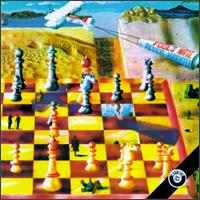 Peter
Hammill, Fool's
Mate (July
1971),
**1/2
Peter
Hammill, Fool's
Mate (July
1971),
**1/2
Hammill
was the singer, songwriter and rhythm guitarist/pianist of Van
Der Graaf Generator, and a unique talent. That band had
either
already broken up, or was about to do so when this was recorded in
mid-1971. Unlike Generator tunes, those on Fool's
Mate
are short and poppy. Well, more poppy than VDGG; the songs are still
world-weary and depressing. Hammill's notes indicates that the bulk
of this material was written three to four years prior, which would
place it in the 1968-69 era. Those were lighter years of naiveté
and innocence, and if these songs would have been right at home next
to albums like From
Genesis to Revelation.
While one can picture a contemporary Peter Gabriel wondering amidst a
wood striking out against school society with his notebook, it is
likewise easy to see Hammill sitting by himself, jotting down phrases
of dejection to pass the time ("Solitude" is the perfect
example). What sets him apart from others is the extent of his
self-centered nature. His is a world of heavy sighs - Why are you
gone? Why am I alone? When are you coming back? Why have you left? I
wish I were elsewhere. The two exceptions are the songs co-written
with a "Smith" (probably one-time Generator drummer Chris
Smith) - "Imperial Zeppelin" and "Viking".
Hammill loosens up on the former, has some fun, as seen by lines like
"of course we all knew it wouldn't work, but what the hell."
"Viking" is more serious, although not excessively so, and
tells the little tale of viking trip. In effect, this song was a
precursor to the Generator's longer epics, although without the
complexity or length. These two songs are very much the exception
here, and notwithstanding them, this album is the romantic's great
triumph of self-expression.
While
Hamill's
naïve lyrics and singing may fully realize his thoughts, they do
not make the album an entertaining listen. There are no "House
with No Doors" here, as musical hooks are far less frequent. He
does have some success with choruses ("Candle", "Summer
Song"), but otherwise there is very little of interest.
Hammill's withdrawn and self-pitying lyrics only take an intriguing
turn in a few places. Otherwise they are simply the notes of a
fragile and spurned youth ("I Once Wrote Some Poems" is
self-explanatory). His vocals are either the soft voice of the
wide-eyed youth ("Solitude", "Vision" among
others), or laced with dramatic flairs similar to David Bowie
("Re-Awakening", "Imperial Zeppelin"). All of the
Generator folks lend support, as are others including Bob
Fripp and some Lindisfarne folks. It therefore does sound
like a
Generator record, and reproduces one of that group's main faults -
the lack of a strong soloist. Fripp filled that hole on H
to He for
a portion of the time, but he does not do the same here, and neither
does anyone else. So, we are treated to the very easily bruised
Hammill lamenting, which becomes depressing after a short period of
time. One wants to shake him by the collar - socialize him - do
something so that he breaks free of this ennui. If you listen to this
record in its entirety, someone may need to do the same to you.
Produced by John Anthony.
 Peter
Hammill, In
Camera (Sep.
1974),
*1/2
Peter
Hammill, In
Camera (Sep.
1974),
*1/2
Perhaps
there were legions of Peter Hammill fans anticipating this release
back in 1974. Pale young boys without much ability to make aesthetic
distinctions. Boys (for I doubt very much many girls were interested
in Hammill's work, except those who favor the sad, self-pitying
type), boys with light complexions, Questions About the World, who
wore doubt like slacks. Those that inhabit college coffee shops and
burn with the intensity that suggests they have probed the surface of
Society and found it a sham. Revelations behind a screen that are
both miraculous, unsurprising and cause an urge to proselytize.
Enter
Hammill, a man whose lyrics have now turned from schoolboy jotting to
overwrought essays. A man whose preferred vocal style is better
suited to operettas - an over-dramatic, spoken/singing style
appropriate to the sole-worn stages of the West End or Broadway. A
man who attempts to compensate for recognized playing limitations (on
an album where he supplies everything but drums, no less), with sound
effects and treatments that had long become the equivalent of parlor
tricks.
Still,
Hammill is trying some new things. His quasi-operatic vocals are now
sometimes turned to growling ("(No More) the Submariner").
The sound effects stuff is also different, but just annoying. "Fear
and F" is the only partially decent song on here - another empty
folk song with Hammill overlaying swooping David Gilmour-like guitar
lines. Other bits of not quite praise - "Again" is another
self-pitying folk tune, much like the bulk of Fool's Mate,
and
"Tapeworm" could have been a kick ass song ... if Sabbath
did it. Hammill's presentation makes it a self-loathing intellectual
ode. Beyond that ... his bass playing is decent. However, the one-two
punch of lyrics that have the defiant, self-questioning stamp of a
pretentious high schooler about them ("(No More), "Tapeworm"
or the unbearable "The Comet") and the the fact that Hammill
wouldn't know a hook if he was standing in a meat locker, makes this
anathema to anyone outside of the aforementioned self-identifies
subculture. It all culminates in "Gog" and "Magog",
a sort of anti-church service (the lyrics swimming in a sub-Heretical
Squid squirty, evil way), which combines a lack of music interest
with a level of pretension that may be toxic.
Hawkwind
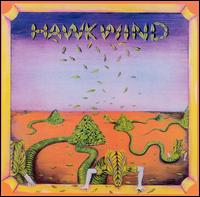 Hawkwind
(Aug. 1970), *
Hawkwind
(Aug. 1970), *
In
1970, Hawkwind released a single - "Hurry on Sundown" backed
with "Mirror of Illusion".
In 1970, Hawkwind
released this album with "Hurry on Sundown" as the first
track, and "Mirror of Illusion" as the last.
Everything
in between is garbage.
Hawkwind absorbed all of the wrong
things from good influences. Thus, they pull the hippie mysticism and
aimless noisemaking of the early Grateful Dead (think Aoxomoxoa
era) but completely miss the melodies and clever lyrics ("Seeing
It as You Really Are"). Or they pull the grand experimental
space-rock noise of Pink Floyd,
and
ignore the underlying structure behind it. Instead, these tracks are
one collective mess with a galloping Saucerful
of Secrets beat,
illuminated only by random scatterings by the rest of the band, and
infrequently punctuated with ridiculous lyrics ("Be
Yourself"). Their attempts at being spooky or creepy
are utterly simplistic (rising diminished chords in "The Reason
Is?" or the one creepy riff overused in both parts of
"Paranoia") such that Floyd was light years ahead of them.
The soloing is pretty aimless ("Be Yourself" has some rote
blues leads by Huw Lloyd), and intermittent (Nick Turner's sax seems
to come and go at will).
Seeking
to
understand what the band is up to, we can turn the back of the album.
There the band explains that "We started out trying to freak
people (trippers), now we are trying to levitate their minds, in a
nice way, without acid, with ultimately a complete audio-visual
thing. Using a complex of electronics, lights and environmental
experiences." So, their approach is based on these three things
- electronics, lights and environmental experiences. Unlike
the
CD version of Pink Floyd's Pulse,
there are no lights involved here. Dikmik's electronics seem to
consist of making wind noises at various frequencies, squelches and
slide whistle noises. You'd be hard pressed to find notes in there.
So, scratch electronics, unless it's part of "environmental
experiences." The environment is tripped out and spacey as hell,
but with a nice dash of hippie "insight" thrown in. So, my
advice is that if you want to enjoy these tracks (as songs may be too
nice of a word), buy yourself a lava lamp, draw all the shades, get
high out of your mind, and put this on.
Unfortunately, the
B-Side/last track "Mirror of Illusion" is also junk. No
fisher king here. So ultimately this album boils down to the question
of ¿How
good is "Hurry on Sundown"?.
The answer is - it's pretty good, but nowhere near enough to carry
the album by itself. It's far different from the rest of the
album - being more like a good acoustic based folk song with a nice
driving beat. "Mirror of Illusion" has the same
folk-gone-slightly-awry feeling, but the band is deliberately
layering their sound, like the rest of the album and trying to more
experimental. Listen, if it's 1971 and you want to trip out
to
something, go listen to Floyd, or some Can or something.
The
band is Dave Brock (vocals, guitar) who wrote everything, John
Harrison (bass), Huw Lloyd (lead guitar), Terry Ollis (drums), Nick
Turner (sax, percussion), Dikmik (electronics). I have no doubt their
other albums are better, as the personnel changed - Harrison's pretty
worthless, although Ollis sounds like a more focused Nick Mason
deprived of his vast percussion collection. Produced by Dick
Taylor and the group.
The
Hollies
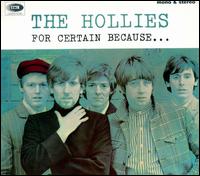 Stop!
Stop! Stop! (1967),
**1/2
Stop!
Stop! Stop! (1967),
**1/2
While many
groups claim to have been the Beatles biggest competitors in the
early days, the Hollies' claim actually has some merit. Not too
much, but they had a good run of hits with their brand of high-end
pop-rock. By this time, however, the Beatles had pulled away
(and into more folky material) while the Hollies continued with their
tried and true formula. This was the first album written
entirely by the band, and they experimented with their formula
(high-pitched harmonies, simple rhythm section, romance-related
lyrics) with limited success. First of all, there's a
surprising amount of banjo (the fun album opener "What's Wrong
With The Way I Live" among others), and the signature harmonies
(which wear on the ear after a while) are not on every track.
They even play around with changing the time signature in a song
(chorus vs. verse of "Pay You Back With Interest" and the
odd reverb piano intro). But even some of Graham Nash's
attempts at being more "serious" either sound forced (the
downer romance of "Clown") or are not terribly interesting
("Crusader" has minor-major changes and fairly advanced
lyrics, but lacks momentum). Among the other tracks there's a
middling Byrds impression
("Suspicious"),
a goofy orchestrated Allan Clarke spotlight track ("High
Classed") and a great Latin-tinged number with actual guitar
lines ("Tell Me To My Face"). The US title track
("Stop Stop Stop") is the only real classic song, as the
band puts a manic banjo line and rather disturbing lyrics in a nice
shiny pop package. Nothing is offensive (other than sustained
listening to their harmonies), nor could it be. The Hollies
were good, but rather straitjacketed, as a pop-rock group,
contributing to Nash's departure and their increasingly out-of-touch
sound in the following years. The band is Allan Clarke
(vocals), Graham Nash (vocals, rhythm guitar), Tony Hicks (guitar),
Eric Haydock (bass) and Bobby Elliott (drums). Produced by
Ron
Richards, and ex-Manfred Mann member Mike Vickers adds orchestration
on some tracks. Released as For
Certain Because
in the UK.
Jeremiah
 Jeremiah
(1971), **1/2
Jeremiah
(1971), **1/2
Basically a solo album from ex-New Mix frontman David Brown,
in a pop singer-songwriter mode. (Tellingly, it was recorded
with some of the musicians which Paul McCartney used for Ram and later
comprised Wings. Drummer Denny Seiwell is even credited as a
member of Jeremiah.) Jeremiah
is unofficially sequenced into a light and heavier side, or is I call
it, asleep and awake. The A side is largely gentle pop songs,
but a few have a pulse (“Sweet Rebecca” and the fake ragtime of “Hey
Baby Don’t You Cry” sound like some McCartney could have done in his
sleep, and “Somewhere Someone” is decent enough). Brown had
the voice for his material, but light pop from this period is more
pleasant than memorable. McCartney is an exception because he
infused most everything with a goofy sense of humor; a similar band
like Tranquility also falls prey to the memory disease of being
inoffensive).
The B side is better, with more a band feel, closer to The New Mix
without the psychedelic lyrics or production. Poor lead
guitarist Pat Walters still doesn’t have much to do, except for “David
Blue” which sounds like The New Mix (minus keyboards), as an actual
rock song and where Walters gets to hammer on some blues
licks. Brown had such a good voice, and some strong pop
instincts that I really wonder what happened to him after
this. I guess he released another album, I Want to Be With You,
as “David Brown and Jeremiah” the next year, then disappeared..
Locomotive
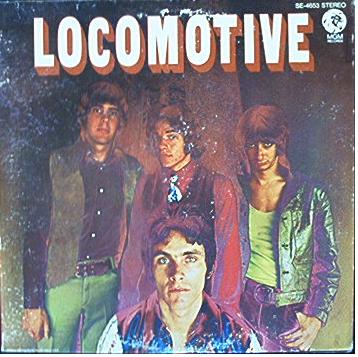 Locomotive
(1969), *1/2
Locomotive
(1969), *1/2
I
have two conflicting opinions of this album. On one hand,
Locomotive
is a pile of bluesy and slightly gruff blues-influenced rock of the
sort that was popular at this time, and ultimately only leaves a
small impression of distaste. On the other hand, Locomotive
was
probably a perfectly decent blues-based bar band, and they have some
talent, and their music isn't irksome - just in one ear and out the
other. Thus, it's a perfect candidate to get two
stars,
which is admittedly my dumping ground for albums that are not too
good, but not that annoying either. Sort of the reviewing
cut-out bin. It's getting dumped down to one and half stars
because at least other 2 star
wonders had a couple songs
that I liked,
and made an impression. Normally, one has to do something really
bad
to
fall below two stars, but Locomotive does not vary their formula
enough to be bad. It does feel like I'm passing judgment on
the
genre, and not the music, which is something I do not want to do, so
if you're a fan of roots/blues rock from this era, feel free to add
an additional star.
Locomotive's
lineup was pretty standard with guitar, bass, drums, organ, which
would have been made sense for a local band. The cover photos
also reflect this - leather vests, blue jeans, big belt buckles, and
out by the railroad tracks. You get the feeling they
presented
themselves as a blue-collar band with some grit, not studio
creations, and not grubby hippies with jam music. Despite
this
no-nonsense appearance, their material is flat out boring.
This
music just pours over you, with all the flavor of purified
water.
It ranges from obnoxious ("Big City Car") to pleasant
("Barbara Jean"), but there's little to discuss. The
repetitive lyrics are all about girls going free, girls not
understanding, buying shiny new cars, etc. Repetition applies
to the music also, as the blues always has the danger of luring
people into the same old scales and chord patterns ("Get on
Away" is one of the one-riff ponies on here). At least
Blues Image claimed to
invent "Latin
Rock," even if it got them nowhere. Guitarist John Ussery
wrote almost all the songs, and he is a functional blues player with
an appropriately slightly scratchy voice. But the band has an
almost ceaseless approach to blues-rock with some contemporary roots
rock thrown in for good measure. Ussery occasionally uses
acoustic ("Barbara Jean"), and Ussery occasionally uses a
wah-wah ("Wah-Wah," "All Come Free" which is sort
of psychedelic),
otherwise it's the same sound. I even like
the
band's sound, but just not what they (don't) do with it. I
sure
would not mind seeing the band as they worked in the Seattle area,
and I bet they were real crowd pleasers. But unfortunately,
this isn't a review of a live show, and their music betrays the fact
that they don't have anything new to say. Give these guys a
pile of Rolling Stones, Muddy Waters, or other blues covers, and
they'd be better. Produced by Chris Houston.
There's no
real reason to own or listen to this.
Ussery
is
still active and
sitting on railroad tracks for album photos wearing leather and blue
jeans. On the off-chance that he's reading this, I'd just
like
to say your playing is decent enough, but if all I remember from your
album is you bawling about wanting a "big-city car," well
then you need to do better. I do
like
the bad-ass mustache you now sport.
Of
course,
one of the main reasons I bought this for the stunning price of one
dollar was that it was reviewed by Rolling Stone in the same review
as Bodine, also on the
erstwhile crappy MGM
label. Yes, did you know you can search the Rolling Stone archives on
line? I looked up Bodine as a test, to see how in depth the
reviewers got, and was surprised that it was covered. The
reviewer made the annoying decision to lump both bands together and
not talk about specifics, which ticked me off. Unfortunately,
his words rang true for Locomotive.
Also,
this
isn't the English
Locomotive,
which had future Traffic
member Chris
Wood.
Man
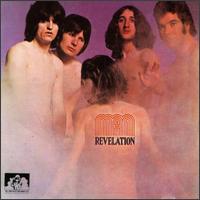 Revelation
(Jan. 1969), ***
Revelation
(Jan. 1969), ***
At
heart Man was a bluesy hard rock rock group, but given the time and
place and all, they had yet to realize it. Thus, they decided
to record a concept album, and incorporate an appropriate amount of
artiness. When you have a name as ambiguous as Man, you could
be either grandiose or down'n'dirty. The album does a bit of
both, as the band runs around and does a bunch of different things,
and then tries to shoehorn them into the concept. What is the
concept? It's never quite clear, but the album appears to be
the story of the evolution of mankind. You are better off
just
forgetting that it is a concept album. The album opens with
"And in the Beginning", and closes with "The Future
Hides Its Face" which are the same song with different
lyrics.
This is the Church of the Blues, featuring a ceremonial and paced
service, and filled with pretentious lyrics ("The ageless face
of time / smiles briefly and is gone / and in its wake leaves nothing
/ save future yet to come"). There's even someone doing
little spoken word lines, exactly like Bible readings. Who is
the preacher here? Vocalist Deke Leonard, who sings like a
acid
prophet or a very young wizard (he bubbles enthusiasm all over "Don't
Just Stand There (Come in out of the Rain)". He sounds
like that guy who's so high, he's got the entire world figured
out.
He could produce the unifying theory connecting Newton and Einstein,
if only someone would run down to the store and get him something to
eat. He sounds like a street preacher, Bob Dylan,
and a
drug dealer rolled into one. "The Future Hides Its Face"
tells us where man is going. (Answer: Space.) The
album
then ends with an excerpt from some anonymous NASA mission.
Space-rock? More like spaced-rock.
It is
not
even funny how much better formed their blues numbers like "Sudden
Life" and the barrel-house fun of "Blind Man", both
written by Leonard, are compared to the rest of the album. In
fact, most of the album was recorded live, with overdubs added, and
it is clear that this was the band's stage show. Man could kick some
roadhouse butt when they chose, as guitarist Micky Jones used a good,
loud distorted tone without sacrificing clarity, and was able to
distort it when needs arise (the end of "Sudden Life").
Even though the band got off track occasionally, they were a cohesive
unit, pretty much everyone is a good player and they mesh remarkably
well. The rhythm section is unusually good without turning to
either the jazzy sound employed by groups like Jethro
Tull or the standard hard rock patterns of a Led
Zeppelin.
Organist Clive John gets some nice faux-classical runs in here and
there ("Empty Room", the fun "Don't Just Stand There")
but does not overdo it. Clearly, their strength lay
in
this area.
Outside
of
the blues tracks, the album is the usual psychedelic grab-bag.
There's the infamous "Erotica", where the band took a jazzy
jam recorded live and then overdubbed a woman faking sex
noises.
Admit it - you knew someone had to tried
this. The
merger works pretty well, and the jam is good with John doing some
nice Doors-like work on the organ. (You know which
organ).
There's a fair amount of what could be either be interpreted as
"artiness," psychedelic grandstanding, or filler.
"Puella! Puella! (Woman! Woman!)" tries to be very
dramatic, with its wordless vocals, and rather unexpected bad flute
playing. Yet, the whole arty dramatic thing works with Jones'
"And Castles Rise in Children's Eyes" which has a
thunderous "Hall of the Mountain King" type of rock, and
has a nice repeating riff. Otherwise there's some real
filler (psychedelic nonsense in "The Missing Pieces,"
and the acoustic "Love" which belongs more in the
repertoire of a French chanteuse).
Thus,
this
is just what you'd expect from a hard rock band in the midst of a
haze of hallucinogens - good when on target with the blues, and
completely erratic otherwise. Produced by John
Schroeder.
I
have their second
album, Two Ounces of Plastic with a Hole in the Middle,
which
is more blues-rock with a surprising dose of artiness as well, and
some of their mid 70s albums like Rhinos, Winos and Lunatics
which are pretty much straight hard/pub-rock sorts of affairs.
Mandala
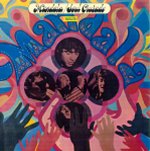
Mandala: Soul
Crusade (1968),
**
Fairly
big-deal Canadian soul band that may have been past their prime when
their lone album was released. Sort of a Canadian Young
Rascals,
centered around singer Roy Kenner, who uses tries to Mitch
Ryder
with a bigger voice. The key to most of these bands is the
playing underneath - it usually needs to be tight for dancing and to
keep the spotlight usually on the singer, but big enough to balance The
Voice. The foundation is solid, both drummer Whitey Glan and
bassist Don Elliot form a tight groove, usually with guitarist Don
Troiano, with both he and organist Hugh Sullivan take
small
steps front from time to time. Some chemistry probably got
lost
in the recording process, but the album's main
problem is that they either needed better songs or
musical hooks. As is, Soul
Crusade
relies too much on Kenner and his "charisma" to carry the album, or
passes Motown knockoffs ("Don't Make Me Cry" and "Stop Cryin' on My
Shoulder"
- lot of crying on this record). Live, I'm sure the band make
them sweat, but in the studio, Troiano distinguishes the songs
through adding in occasional horns or strings, or preach and have your
friends testify ("Faith" which closes the album.) All the
add-ons cannot compensate for behind the times production or adventure,
with only a minor attempt at experimentation-- "Mellow Caramello
Pallambo", a blues jam where Troiano messed with tape speeds, and which
Zappa made look passé by 1966. Lyrically,
it's
a combination of "gotta have faith", "everybody is brothers", "babe, I
love you" (and crying). I credit Troiano for writing and
producing almost all the songs, but this is the rare case where,
perhaps the
band should have done a few standards. Their lone
outside
choice is "Love-Itis", a forgettable song given the same treatment as
all the rest, despite being a Canadian hit. Still, the almost
total lack of solos (Troiano has a fuzzed-one on "Love-Itis"), booming
soul sound and basic production make this
sound like it was from 1966, not 1968.
Glan,
Troiano and Kenner,
plus another bassist, recorded an album as Bush. I have that
somewhere. Kenner and
Troiano showed how not to balance a big voice with the
James Gang.
Manfred Mann
Manfred Mann don't have a
stellar reputation - both of their US hits
remain pretty dumb songs, and in his autobiography Ray Davies says that
Mann was a jerk who claimed he was sending up the whole scene.
(Not that Ray Davies is a reliable source). Anyway,
Manfred
Mann the band was a second-tier pop group that had a bunch of garbage
pop hits in the UK for a few years. Encouragingly, some of
the
people involved are interesting. Jack
Bruce was their bassist for
a bit, in between John Mayall and Cream. His replacement,
Klaus
Voorman was a Beatle associate, and one of their earlier members became
a conductor and arranger. Singer Mike D'Abo was in the original Jesus Christ Superstar.
(Mann himself was their keyboardist, and didn't sing or
really
write their music, although he was an early adopter of the mellotron.)
The band had a rather frightening amount of charting
singles before quitting in 1969. Mann
himself went into jazz-rock and prog, most notably with the Manfred
Mann Earth Band; I have a pile of Earth Band albums I've never listened
to.
 The Mighty Quinn
(May 1968), ***
The Mighty Quinn
(May 1968), ***
An American bastardization of the UK album Mighty Garvey! with
some tracks removed, and some hideously "Electronically Altered to
Simulate Stereo." Mike D'Abo is a strong singer whose
slightly
pinched
voice sounds like Arthur Lee of Love, but with a soul tinge.
(Perhaps a less showy Carl Wayne). You'd be hard
pressed to
hear the guitar on many of these tracks, as their sound was based on
Mann's piano, often overdubbed with mellotron. Up front are
two garbage pop singles - a cover
of Dylan's "The Mighty Quinn (Quinn the Eskimo)"
probably successful because of the catchy "Come on without / come on
within"
chorus, not for Dylan's inscrutable lyrics. (I'm comfortable
with
Dylan, but this is junk). That's followed up by "Ha Ha Said
the
Clown", probably the quintessential 60s junk pop song: guy goes to a
clown, becomes enamored with a woman dancing, then YONK turns out
she's the
clown's wife. Ha ha said the clown. Written by an
outside
songwriter (like most of their junk singles), and imbued with a
bouncing beat, I categorize it as So dumb it's Enjoyable.
(Even
though it's also in fake stereo.)
Beyond those two tracks, The
Mighty Quinn
is pretty interesting, although derivative/not as good as other pop
strains floating around at that time. But first, let's talk
about
the the album's best track, "Semi-Detached Suburban Mr. James",
technically a two year old garbage pop single by the time this was
released. Thing is, it's a great song,
something like The
Move crossed with The Kinks,
produced by
Shel Talmy. (Of course, it is a first person tune, basically
about
"hope you have fun marrying that boring guy in the suburbs" while if it
was a Kinks song it would be third person and probably commend the
suburban lifestyle.) It's a punchier tune than the rest, and
has
an early use of mellotron.
It's hard to tell what the "natural sound" of the Menn would be, beyond
empty commercial pap. The rest of the album is largely good
psychedelic/art-pop, written by either singer Mike D'Abo or
drummer Mike Hugg. Compared with their
earlier works (and the garbage pop), it sounds like Mann + Co. really
started listening to Pet
Sounds at
some point, adopting overlapping vocal harmonies and scant
guitar.
This matched well with their focus on Mann's keyboards and
D'Abo's voice, and the former's generous use of the mellotron to fill
in their sound. The band were not impersonators, but their
influences are obvious - Hugg's excellent "It's So Easy Falling" and
guitarist Tom McGuiness's "Cubist Town" bear the Beach Boys mark.
The influence is audible on lesser songs like "Every Day
Another
Hair Turns Grey" (melancholic Beatles) or the bouncing "Country
Dancing" (Donovan). D'Abo's "The Vicar's Daughter" better be
parody, with lines like "tried things I didn't outta."
None of
it really rises to the level of Odessey and Oracle,
for example - nor would you find "Big Betty", a semi-parody of a
mid-60s dance song with bamma-lamma lyrics on a Zombies album.
(The inclusion of which suggests that Mann may have been
taking
the piss, even if it's stupid fun.) The same strengths -
D'Abo voice and the not particularly distinguished backing, make their
soul pop songs pretty decent ("Each
and Every Day" or "No Better, No Worse"). I hold out
hope for the UK release, as it has even more group originals.
Self-produced, save the 1966 Shel Talmy track.
(The band had a few more hit singles after this that are . . . garbage
pop. I've heard a couple of tracks from a soundtrack they did
around this time, which are excellent chill Beach Boys-like songs with
staggered backing harmonies.)
Metro
 Metro
(Feb. 1977), **
Metro
(Feb. 1977), **
1977
was not an particularly good year for old-wave music, and Metro
is no exception. The group attempted to slot into glam and
pop
and the approach is decent: Peter Godwin's breathy vocals, a polished,
sexualized bitchy tone and sleek production. In other words,
Metro was the drug-sniffing, decadent debutante to Japan's sleazy,
enthusiastic debauch. Metro's sole claim
to
fame is the decent song "Criminal World": a polished piece glam pop,
with Godwin breathing his way through double entendres, very
traditional 70s guitar work, and a talkbox. But for all their Eurotrash
poise, Metro has strong inherent downsides: Godwin is a very
milquetoast Bowie ("Black Lace Shoulder"), neither Duncan Browne nor
Sean Lyons were much of a rock guitarist, and the album rarely gets
loud, lingering in some shiny decadent netherworld.
While
some new wave elements are present, Metro arrives there
from contemporary trends, rather than breaking with the
immediate past. Former orchestral pop artist Browne's input
is
very audible: the classical guitar sounds ("Overture to Flame"),
periodic choirs ("Precious", the fine "Jade"). The result is
something like a wealthy Eurotrash early version of Japan or Colin
Blunstone crooning glam ("One Way Night", "Paris"). "Overture
to
Flame" is Metro at its most intriguing, echoing the classical
fashionings of the Durutti Column ("Overture to Flame") and playing
around with disco beats. Perhaps there was room for a
lighter,
"classier" glam album that dove into mainstream pop, but Metro was not
it. In the end, it's all well-heeled posturing, mere exhaling
rather than moving, and mainly remembered because Bowie later covered
"Criminal World".
(Studio
musicians Simon Phillips (drums) and John Giblin (bass) rounded out the
group). Metro released a couple of non-Browne albums
afterwards.
Milkwood
Tapesty
 Milkwood
Tapestry (1969), **
Milkwood
Tapestry (1969), **
This has to be
one of the stranger albums I have come across - not for any zaniness
or strange sounds (a la Zappa, or any of his ilk), but for their
strange dualistic approach to music. Milkwood Tapestry was an
off-kilter folk/rock duo, by which I mean they play folk, and they
play rock, but no real combination of the two. It is not
exactly Peter,
Paul and LSD,
but that should give you the general idea. On the rock songs
they resemble a lackluster West Coast hard rock group, thanks to
Roland G. Antonelli's bluesy guitar playing and the clunky and
obvious session work along with him ("Journey-less Ride").
But the key component is his partner - singer Joseph Ransohoff, who
contributes poetry to all the songs (including the heavy ones) and
turns his vibrato-laden voice (one of the most annoying vibratos
along with that guy from the Bee-Gees) into derangement ("Beyond
the Twelve Mile Zone"), screams and screeches on the "hard"
tracks. The mixture is decidedly odd - for example, "Signs
of Invisible Chalk" opens with the line "All the little
ballerinas / Have pink tights on" to chugging accompaniment with
screeching thrown in later. The result is one of the most
unintentionally funny tracks I have ever heard. The best
example of their off-kilter rock sound is the eerie "Tockless
Time Morning". On the other lighter side, the album has
twittering light songs about love, window-sills and the like,
frequently done with Antonelli's light baroque orchestration.
To make it even odder, despite Ransohoff's lame-o smiley-faced sound,
it is done with all the earnestness of a pair of children's
performers. There is
something
child-like about these songs ("Seas of Marshmellow Bees" a
doped-up love song with the most elementary rhymes in existence, or
"Look at the Children" which I noted is 'more smiley-faced
circus crap') almost to the point of nausea, while still directed to
an adult audience. They sound like an actual folk duo without
any accompaniment once, and "Sunday Raindrops" is without a
doubt the best track, with Antonelli providing some lonesome
classical guitar to Ransohoff's controlled singing. However,
the song's arrangement is the lone non-rock one. Without a
doubt this is the stuff to make fun of - entirely serious and
incredibly dated. I concede that it's entirely possible for
someone to love it lock, stock and barrel, unlike, say Ultimate
Spinach. So dang idiosyncratic it's bound to have
fans out
there. I am not among them. Produced by Manny Kellem, and
engineered by Bon Jovi's relative. The strangest thing of
all?
The fact that it's been re-released on CD (since I bought my
copy).
Despite the fact that I gave them half a star extra for being so dang
weird, I would have no problem if all the copies of this album were
somehow destroyed.
The
Mindbenders
 The
Mindbenders:
A Groovy Kind of Love
(1966), **
The
Mindbenders:
A Groovy Kind of Love
(1966), **
As Wayne Fontana & The Mindbenders, the group some hits in
both the UK and the US ("The Game of Love" being the most famous, I
think). Fontana left for a solo career, and the rump carried
on
The Mindbenders. The title track was a big hit, but the rest
are
middling covers of familiar songs, almost all with the same
vaguely echoing
production. "A Groovy Kind of Love" is good, despite
dated, and guitarist Eric Stewart has a decent enough voice.
Nobody really distinguishes themselves instrumentally;
Stewart's
guitar
leads are unremarkable (the blues on "All Night Worker"), and sometimes
he repeats the vocal line
as the guitar solo (the title track). But even though the
band
could
play their instruments, recording a bunch of covers makes it seem like
they were playing the school dance. There is no good
reason to listen to Mindbenders cover The Temptations ("The Way You Do
The Things
You
Do") or The Chiffons ("One Fine Day"). The album helpfully
does not identify the
songs' authors, but even if some of these songs were originals, they
lack spark. "Can't Live With You, Can't Live Without
You" and "Ashes to Ashes" were follow-up singles to their hit,
but
neither quasi-ballad has much of interest. Half of these
songs
could be from 5 years earlier, and the band's adapting to each song
means they seem to lack an identity. The result is that they
come
across as faceless and behind the times, like a tame and lame sibling
to The Zombies.
No producer credited (no surprise).
The band released a second album, With Woman in Mind,
the following year. After the three singles taken from /
compiled on this album, they released seven more,
most of them covers and I believe all of them flopped.
Stewart founded 10cc a few years later with late-era
Mindbender Graham Gouldman.
Mountain
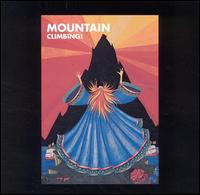 Mountain:
Climbing!
(Mar. 1970), ***1/2
Mountain:
Climbing!
(Mar. 1970), ***1/2
If
this album sounds like Cream
revisited, that
is because Mountain was the brainchild of that Cream producer Felix
Pappalardi. However, guitarist Leslie West doesn't try and
sound like Clapton, and the group's songwriting was
excellent.
Climbing!
sounds like it was written before the whole Zep and metal rage took
over, with references to rainbows and sunshine. The songs are
roughly dividable into those Pappalardi sings, and those West
does.
West's are slightly lesser, relying on gut power vocals, loud riffs
(the hit "Mississippi Queen") and even a song that has a
bagpipe imitation on organ ("Silver Paper").
Otherwise, "Never In My Life" is nice but does not quite
overcome its riff. There's even a Page style acoustic solo
number (the great "To My Friend"). Pappalardi played
similar to Jack Bruce on bass (great) and was a better vocalist ("The
Laird", and one of my favorites "Boys In the Band").
It does not hurt that the second track is an excellent Bruce-Brown
song "Theme for an Imaginary Western". "For
Yasgar's Farm" combines both styles with excellent results.
Overall a listenable fun hard rock album with only a few weak
numbers.
The New
Mix
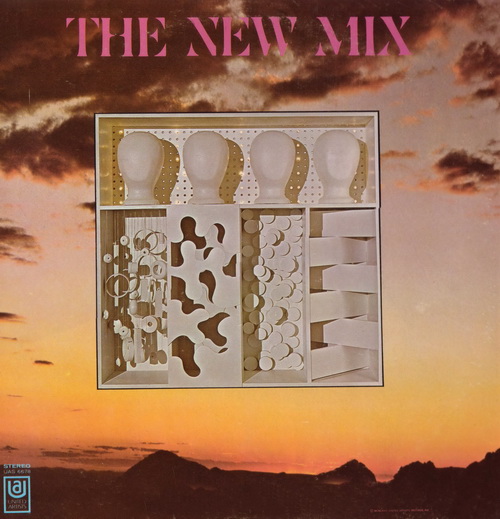 The
New Mix (1968),
***1/2
The
New Mix (1968),
***1/2
Good pop album that walks the line between the psychedelia of The Jefferson Airplane and
the sunshine of The Mamas and The Papas. It’s a fine line,
because it would be very easy for a braindead pop group from a minor
town (Charlotte, NC, no offense) to thrown in some groovy production
techniques on their way to become an historical footnote. But
The New Mix
is smart; for example - “While We Waited,” the ominous opening
track, which creates a lot of mood out of a fast pace, Rob Thorne’s use
of a snare/tom drumbeat on the verses, Henry Steele’s moody organ and
some San Franciscan burnout lead guitar. (Those guitar parts are probably
from friend Wayne West, Brown seems to stick to
rhythm.) The melancholy shows up in other places (the quiet
intro to “Doorway to an Open Light” for instance), but this is very
much a pop album. Proof is in the careful use of vocal
harmonies on the “Nothing Matters More” and “The Man”, the studio horns
that provide an unexpected ending to “Ever Brighter.” There
are a number of psych-pop little masterpieces like “The Man”,
“The New Harpoon Song” and “Get Me Out” with more of that burnout
guitar, and “Ever Brighter” capitalizing on Brown & Steele’s
ear for hooks and the latter’s garage-band organ. Even their poppier
songs avoid being super-drippy, even though a flute crops up “(“Ursula”
which has a pessimistic mood about it, “Nothing Matters More” with its
very West Coast vocal harmonies). Even a one-hook song like
“Sun Down” comes across as catchy, probably because Thorne’s drum fills
are so awesome. Worth seeking out. Produced by
Tommy Kaye.
Brown and bassist Karl Jarvi moved on to
Jeremiah, and Thorne was later in The Spongetones.
New
York Dolls
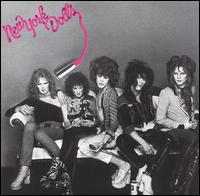 New
York Dolls (July
1973),
****
New
York Dolls (July
1973),
****
The
New York Dolls are often hailed as "proto-punk" for a host
of reasons, including their bizarre stage personae (note the album
cover and their roller skates), crunching guitars and future Sex
Pistols organizer Malcolm McLaren's failed
management.
McLaren's management is a story unto itself, as every strategy he
adopted backfired, even though similar tactics later worked for the
Pistols. Pistols fans may come away disappointed - there is
little nihilism, and the band uses a combination of glam rock, Mick
Jagger-like vocals, and cranked up guitars. The British glam-rock
movement always had a kitschy fascination with the 50s, which usually
appeared as a tepid revival in America. Fortunately, the Dolls fall
more into the first category, playing a cross between straight-up 70s
rock and the old retro sound, resulting in some turbocharged
performances ("Personality Crisis", "Trash").
Sometimes the 50s feel predominates ("Lonely Planet Boy"
with its loose sax line, "Pills" the ending of "Subway").
David Johannson is a front-man of the Jagger swagger style, as
opposed to the dark twisted nature of an Iggy Pop. Still, Sylvain's
blistering guitar sets the band apart ("Frankenstein" is a
real monster, or "Jet Boy"), foreshadowing the Pistols'
hard rock sound. The band was far more interested in bitching
about their "baby" than society at large, and their lyrics
owe far more to the confused hyper-sexuality of the early 70s
("Personality Crisis", "Looking for a Kiss") and
New York sleaze ("Bad Girl"). Only a few weaker
tracks hold this one back ("Private World", "Jet Boy",
the calmer "Lonely Planet Boy"), but otherwise it is a
celebration of a time when men could dress up in drag, wear roller
skates, be otherwise decadent and still be real men. In the
end, the amount of talk surrounding the New York Dolls will guarantee
them a place in "pre-punk" history, even though they have
more in common with Mott the Hoople's All
the Young Dudes than
Never
Mind the Bollocks.
Produced by Todd Rundgren.
Laura
Nyro
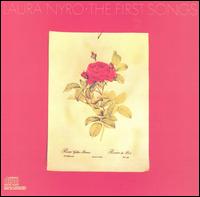 More
Than a New Discovery (Feb.
1967),
***1/2
More
Than a New Discovery (Feb.
1967),
***1/2
Not
really a normal singer-songwriter, Laura Nyro sometimes is just
recognized for the latter. Superficially she bears a
resemblance to Carole King - both were female pianists and pop
songwriters. But Nyro was more than a simple songwriter; not
only did she have a vastly better voice than King, but she was a
better and more interesting musician. Yet, King found vast
success as a solo artist, and Nyro did not. Based on this
record it is not surprising either, despite its trailblazing nature
(how many women singer/pianists were there in 1967?) More
Than a New Discovery
bears all the hallmarks of the New York folk scene--strong vocals,
endless uncredited session musicians--but is removed from folk or
rock. Nyro's songs are in a commercial soul-pop vein
("Goodbye
Joe", "Wedding Bells Blues", "Stoney End"
all given Supremes-like treatments) or gospel ("And When I
Die"), and later found popularity in the hands of others.
That's only half the story - Nyro also delivered a string of
powerfully sung jazz ballads ("Billy's Blues", "Lazy
Susan", "Buy and Sell") where she borrows her vocal
phrasings from people like Ella Fitzgerald. While her vocals
are given center stage, sometimes the backing becomes intrusive
(especially on "Billy's Blues" and "Buy and Sell").
The rest of the album is along the same lines, but without any real
substance ("California Shoe-Shine Boys" is downright fluff)
as if the label needed more commercial material to market the
album.
It takes a while to reconcile the various parts of this album, but it
is well worth it. Even at 19, Nyro was vastly talented, but ahead of
her time. Later re-released as The
First Songs.
Produced by Milt Okun.
 Eli
and the Thirteenth Confession (Mar. 1968),
***
Eli
and the Thirteenth Confession (Mar. 1968),
***
While
Nyro proved to be adept at writing innocent pop songs and ballads on
her first effort, Eli
shows
a
more mature writer. Most of these songs would not fit on New
Discovery
at all: an ode to imbibing ("Sweet Blindness"), a
relatively hard-edged social commentary ("Poverty Train"),
and more adult love songs (the album's closer "The Confession"
ends with the lines "love my lovething / Love is surely
gospel"). The New York folk backing is gone, and producer
Charles Calello replaced it with pop-rock supporting players, as well
as strings, horns and whatever else wondered into the studio.
Certainly not all of them are always present, but periodically Nyro
gets lost underneath it all ("Woman's Blues" or the bombast
of "December's Boudoir"). As for Nyro herself, the
production emphasizes her exceptional vocals once again (she does
plenty of multi-tracking also), but her craft had matured as
well.
Perhaps a bit too much for her own good, actually. Her song
construction has gone a bit loopy, changing rhythms within songs,
stopping and starting, while her lyrics have become slightly
muddled. At some points you know what she's singing, but
you're
not quite sure what she's going on about ("Once it was Alright
Now"). If this sounds a bit like Astral
Weeks
to you, you'll be pleased to know that at least one track has the
same jazzy feel that Van Morrison later used with great success
("Lu"). One almost wonders if someone told her not to
record any true ballads, as any song that starts out that way
inevitably winds up in fast tempo pop-rock at some point ("Emmie",
"December's Boudoir"). When she does stick to more
normal structures it's very successful ("Luckie", "Eli's
Comin", "Stoned Soul Picnic", of which the latter two
became hits for others), while her complex stuff shows it's
age.
In general, Nyro tried to push pop's boundaries here, but it doesn't
quite work, and she isn't helped by the production.
Osibisa
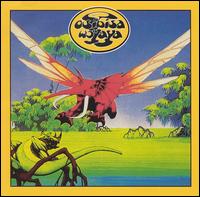 Osibisa:
Woyaya (1971),
****
Osibisa:
Woyaya (1971),
****
Sometimes you
take a chance and it pays off. I bought this solely because Roger
Dean did the cover art (that guy who did lots of Yes
work), and it then proceeded to sit in my closet. Of course,
that turned out to be a mistake, but that's life. The group is four
guys from Africa and three from the Caribbean (traditional dress and
everything), and they produce a truckload of cool percussion.
I
can't dance, but this made me wish that I could. It also
means
I am less qualified to discuss this than an ordinary rock record, but
phooey on that. I also may draw some flack for this
comparison
(as if anybody reads this), but Osibisa is like a much better, less
rocking and more focused Chicago (the opening of "Y Sharp"
in particular). Certainly, the compositions are different,
but
there's a general similarity. Osibisa has a thick sound with
all the percussion, horns, guitar, bass and drums. There's
even
a chorus in places. Big sound. The opening track
"Beautiful Seven" starts out with thunder and then an
echoed flute. Put a guitar in its place and it could pass for
a
Santana track. If that didn't warn you, there's a good dose
of
jazz present, but in a much different way then some sort of fusion
album. But there's little (if any) self-indulgence, instead
it
just builds on the beat thumping away underneath. You can't
dance to fusion, you can dance to this. Not quite a rock
band,
they do cool stuff like vocal percussion "Survival", or
Roland Kirk's "Spirits Up Above" which is like a jazz jam
wedged in the middle of a gospel song. The back side wanes a
bit, but it's still a fun album. I almost forgot the coolest
thing of all - the bass player is names Spartacus R. Produced
by Tony Visconti.
The
Peanut Butter Conspiracy
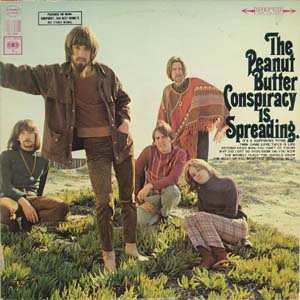 The
Peanut Butter Conspiracy is Spreading (Mar. 1967),
**1/2
The
Peanut Butter Conspiracy is Spreading (Mar. 1967),
**1/2
The
Peanut Butter Conspiracy may not be the worst name in rock history,
but it certainly could only be thought clever in the 1960s. (See
also
Frank Zappa's humor). The Conspiracy were among several
Byrds-influenced folk-rock
groups inhabiting
L.A. in the late 60s, although they had a greater pop feeling than
others like Clear Light, due the influence of Beach Boys and
Sagittarius producer Gary Usher. They had a strong female lead
vocalist in addition to the men (Sandi Robinson), such that they
often sound like a revved up version of the Mamas and Papas. They
wrote their own material (usually Bassist Al Brackett or guitarist
John Merrill) which used fairly quick chord changes, often
down-shifting the tempo for the chorus (a clever trick you can hear
on the best tracks on here: "It's a Happening Thing", "Dark
on You Now", and "Twice is Nice"). They may be fast,
but almost every guitar break is incomprehensible ("It's a
Happening Thing", "Twice is Nice"), and according to
the liner notes Usher brought in session musicians. Usher goes for
lush pop on only one track ("Then Came Love"), and adds
bits and pieces elsewhere. There are a couple of forays into jugband
territory ("Second Hand Man", "You Took Too Much")
and a mysterious Old World or Eastern song ("The Marketplace"
with delightful squealing horns) to keep it interesting. Their
folk-rock alone dates the band, and their lyrics are also firmly
rooted in 1967. The opening track ("It's a Happening Thing")
has Sandi proclaiming that "Love is the grooviest thing / up
till now, in the world." It gets better. There are some drug
references, some perhaps cautionary ("You Took Too Much"),
culminating in the All-Time Most Hilarious Anti-Drug Song: "Why
Did I Get So High", which needs to be heard to be believed. It
opens with Robinson asking, "why did I get so high? Just to fall
from the sky" while the band plays a vaguely classical tune
(suitable for a harpsichord). It is not a bad song, perhaps just a
sign that the L.A. scene was falling into self-parody. Even today the
album is enjoyable, especially if your taste runs to charged
folk-rock.
The
rest of the
band was Lance Fent (guitar) and Jim Voight (drums).
 The
Peanut Butter Conspiracy: The
Great Conspiracy (Dec. 1967),
**
The
Peanut Butter Conspiracy: The
Great Conspiracy (Dec. 1967),
**
On
their second album, the Conspiracy continued their psychedelic
folk-rock. Without Gary Usher producing, the band moved towards a
darker and longer songs with more instrumental sections. The
Great Conspiracy has
a very California feel:
trippy instrumental sections, electric guitar lines over folky
guitars, the blues lurking in the background, Mamas and Papas vocals,
and psychedelic lyrics. Such a shame that the lack Usher's mainstream
push also resulted in really dull songs from Merrill and Brackett.
The lyrics are no longer laughable, just delightful drug nonsense
("Invasion of the Poppy People", "Captain Sandwich"
to name a few). They could play fairly well (especially Brackett's
bass lines), but for every interesting instrumental section (the
break in "Turn on Friend (To The Good Life)", "Captain
Sandwich") there are deadening downer tracks ("Too Many
Do", "Ecstasy"). Drugs caused most bands to play
unusual music, go nuts or make distinct music. Not so with the
Conspiracy; the ticking guitars in bassist Al Brackett's "Time
Is After You" are the closest thing to innovation or real
exploration. Otherwise, dull dull dull, which is the worst kind of
album to review. The band may have been great in person, but the
entire scene had just about run its course, and it shows. Everyone
was packing up to move onto horn rock, soft rock, country rock or any
genre that did not require much in the way of dazzling skills.
The
band
replaced Fent with Bill Wolff for this album. Included on my reissue
is a post-album single, "I'm a Fool" which is a soul and
horns track, and not bad at all with Robinson's voice. The band
released a final album in 1969, For Children of All Ages,
on a
small label before breaking up.
Pearls
Before Swine
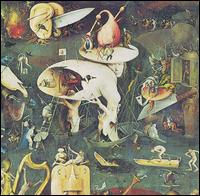 Pearls
Before Swine: One
Nation Underground
(June 1967), **1/2
Pearls
Before Swine: One
Nation Underground
(June 1967), **1/2
Another album
designated as "underground" (even in the title), but one
with "underground success." The man behind Pearls
Before Swine was Tom Rapp, a confirmed folkie who got some friends
together to record this album fairly quickly in New York. One
Nation Underground is
a strange blend of folk guitar, Farfisa organ and nice ornamental
touches with rather poetic lyrics, resulting in a crystallized
sound. It sounds best when Rapp fingerpicks and gently sings
verses in an unhurried voice ("Another Time" with wonderful
additions of autoharp and finger cymbals, or "Morning").
On the whole, the band sounds like a group of very high
folkies.
Sometimes this works ("Drop Out" - pretty blatant there, or
the mock Victorian mania of "(Oh Dear) Miss Morse" with
naughty Morse code and banjo), but for the most part they are too
spaced out to hold interest ("Regions of May", or the
really trippy "I Shall Not Care"). Part of the
problem stems from the fact that Pearls Before Swine was not a real
band. Sometimes the players sound like they are only backing
Rapp, or not sure what's going on, while the situation probably
limited their ability to play their instruments. Mismatched
session drummer Warren Smith does not help the situation, with his
egregious overplaying on "Playmate", a track further
rendered a dud by Rapp's inexplicable Dylan-like singing.
Rapp
himself is also part of the problem: upon closer listening he sounds
like he has a slight lisp, and his hoarse yelling adds nothing to the
protest song "Uncle John". While folk music doesn't
overly lend itself to using a variety of chords, some songs are
almost identical musically (he like to hover between D and C on both
"Another Time" and "Morning", and "I Shall
Not Care" is partially based on "Drop Out" which
itself uses a chord pattern found in almost any 50s song).
The
only time the band sounds like they are together is on the ethereal
"The Surrealist Waltz", which sounds great until the
vocalist (not Rapp) starts and one realizes he has almost no voice at
all. It's no accident that this was the only track written by
non-Rapp members of the band. Despite all this, this album
has
a rather unique sound, but is frustratingly inconsistent. The band is
Tom Rapp (guitar and vocals), Roger Crissinger (organ), Wayne Harley
(banjo, mandolin) and Lane Lederer (bass, guitar).
Why
the public library has an Italian import copy of this album I may
never know.
Queen
Someday
this will
be its own page -
after I dredge up my copy of Queen II and Sheer
Heart
Attack.
Personnel:
Freddie
Mercury (vocals,
piano); Brian May (guitar, some vocals); Roger
Taylor
(drums, even fewer vocals thank God) and John Deacon
(bass).
With
their
distinctive vocal
harmonies, wide range of styles and sense of humor, Queen deserves a
place in any classic rock collector's library. May had a
unique
guitar sound, and Mercury was an incredible vocalist with a range to
make women envious. Taylor was a drummer who thought he could
sing (dreadful) and Deacon occasionally breaks out the upright to add
a nice tone to things. However, the group was very
democratic,
for better or for worse, and all members got to contribute
songs.
With "No Synthesizers!" proclaimed on their albums, the
group used massive overdubs to achieve their sound, with both their
guitar parts and trademark harmonies. Whatever your issues
with
either synths or overdubbing, don't let them be a hindrance from
trying Queen.
 Queen
(July 1973), ***
Queen
(July 1973), ***
This was
recorded over three years and man, some of this stuff is
weird.
The first song, May's "Keep Yourself Alive" is the
blueprint for their later success: fast driven, harmonized glam rock,
with Mercury's soaring vocals and May's interesting guitar
leads.
The rest of the album isn't the same. Queen had already started using
multi-part song structures, but Mercury had yet to master
songwriting. So, the quavery piano-pop goes hard rock "Doing
All Right" or the glam-rock-goes-gospel number "Liar"
just do not work correctly. There's even a bizarre
psychedelic
piece ("My Fairy Queen") that relies heavily on Mercury
overdubs. Other songs are unspectacular rock, the breakneck
Taylor piece "Modern Times Rock 'N' Roll" is annoying, and
"Son and Daughter" is a Zeppelin rip-off. But, my
favorite would have to be May's "The Night Comes Down" with
Deacon on upright and May on acoustic. Gorgeous.
Produced
by John Anthony and Roy Thomas Baker.
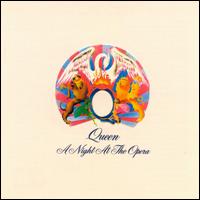 A
Night at the Opera (Dec.
1975),
****1/2
A
Night at the Opera (Dec.
1975),
****1/2
One of the
better 70s records I've heard. Anyone who's seen Wayne's
World
is familiar with "Bohemian Rhapsody", and the excellent
ballads "You're My Best Friend" and "Love of My Life"
get well deserved radio airplay where I come from. But the
remainder is diverse and top-notch, with few exceptions.
"Death
on Two Legs" and "Sweet Lady" are hard rock, without
being annoying (see Led Zeppelin at this period for examples of
annoying). The music-hall type numbers, which remind me of
the
Kinks' "Lazing on a Sunday
Afternoon":
"Seaside Rendezvous" and "Good Company" benefit
from the Queen harmonies and Mercury's vocal range (particularly
"Seaside Rendezvous" with it's suburb lead vocals and vocal
renditions of instruments). But, if the best Mercury
composition is "Bohemian Rhapsody", then May's is "'39".
That is one of the best kick ass acoustic songs I've heard in a
while. The only down moments are Taylor's "I'm in Love
With My Car", which suffers from a slower tempo and his annoying
voice, and "The Prophet's Song" which at 8+ minutes is too
long. Other than that, the album is a classic and deserves to
be listened to immediately.
OK - at least soon
(if you haven't yet, and like that sort of thing).
(I have the
Elektra 7E-1053 LP.)
Rare
Bird
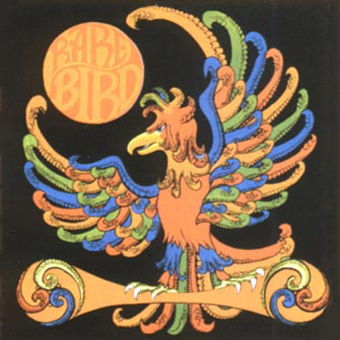 Rare
Bird (Nov.
1969), ***1/2
Rare
Bird (Nov.
1969), ***1/2
Dark
art-rock, albeit with a distinctly Procol
Harum flavoring; Rare Bird has an interesting sound, no
doubt. The band uses no guitar, instead relying on two
keyboardists - organist Graham Field, and electric pianist David
Kaffinetti, in addition to the standard rhythm section. From
Procol Harum they drew plenty of ominous minor chords, but in keeping
with the times it's far faster, far punchier, and far more
instrumental. Despite Rare
Bird's
obvious prog-rock feel, the blues is always lurking somewhere in the
background or in bassist Steve Gould's vocals ("Times" is
the most overt example). It's not like the whole album is an
frenzied rendition of "Repent
Walpurgis", but you get the idea. The band seems to
care about atmosphere and rhythm more than lots of notes. Not
that they don't have quick little runs, or solo sections, just that
the band is fairly discreet. Drummer Mark Ashton's
performance
is almost worth the price of the album alone. He really
propels
the music, and is in Carl Palmer
territory speed-wise ("Beautiful Scarlet"). Producer
John Anthony simply lets the band play, but correctly places Ashton
up front while the keyboardists fill in behind with their interesting
holding patterns. This is in contrast to other groups, where
the organ is usually right in your ears the entire album. The
band's other main influence seems to be the Nice's
first two albums, which raises a automatic caution flag. For
example, "God of War" is built around a catchy evil riff,
but the vocals are a bizarre whispered affair derived from "Dawn"
(with Gould singing the song's title over and over).
Elsewhere,
the opening and closing parts of the last song "Melanie"
feature Gould doing a annoying Lee Jackson impression, although
"Times" is a harmless Ars
Longa Vita Brevis-like
jaunt. It's not all atmosphere of course, and the band is
successful when they keep things moving ("Nature's Fruit",
the hymn-like "You Went Away"). But the longer songs
are hardly losers - both "Beautiful Scarlet" and "Iceberg"
do a good job of contrasting sections, although the former is the
hands-down winner, and as the opening track, the instant hook for the
listener. Lyrically, the album is a vague late 60s mishmash,
with everything from odd devil imagery ("Beautiful Scarlet"),
help the world (the trudging anthem "Sympathy" which was a
minor hit single, "Nature's Fruit", "Bird on a Wing")
to more romantic songs. Anthony's rather basic (or
minimalist,
if you prefer) production, each band member's use of a sole
instrument (although Kaffinetti does distort his electric piano in
places, making them briefly sound like a Canterbury band), and all
the minor chords can make this a wearying listen after
awhile.
But, fans of the dark
Procol Harum, or early prog-rock in general will get a real kick out
of this. The band recorded one more album (As
Your Mind Flies By)
with this lineup before Fields left. All songs are credited
to
the group.
Renaissance
 Renaissance
(1969), ****
Renaissance
(1969), ****
The
early days of progressive music are really interesting because people
were working traditionally non-rock music in with rock any way they
could. It is also interesting to note that, with rare
exceptions, the bands and musicians making this music were
new.
Renaissance was one of those exceptions, and had a weird dynamic to
boot. On one side you have Keith "Collapsed Lung"
Relf (vocals, guitar) and Jim McCarty (drums) from big-deal R&B
band the Yardbirds. Relf and McCarty had never been just plain old
R&B enthusiasts, and this album reflects Yardbirds songs like
the
neo-chant "Still I'm Sad" or the traditional folk of "Only
the Black Rose." With Relf and McCarty writing the basic
songs, Renaissance follows this line (the chorus on "Kings and
Queens" has some of the chant feel to it). On the other
side there was John Hawken on piano from R&B one-hit wonders
the
Nashville Teens, and newcomer Louis Cennamo on bass. They are
the players who made the music work. Relf was never a great
vocalist--at his best he was simply good, with a distinct voice--and
having just picked up a guitar, he was still in the awkward strumming
phase. Indeed, producer Paul Samwell-Smith, another
ex-Yardbird, tends to bury Keith's guitar at his first chance.
McCarty, while a fine drummer of the mid-60s variety, is still only
the drummer. Hawken and Cennamo are instrumental gods, plain
and simple. It's an easy formula. You take a
Relf/McCarty
song and then Hawken and Cennamo drop in classical sections borrowed
from famous works. It's not terribly integrated, but their
interplay is so good it's hard not to be impressed. The
result
is longer songs where the two non-Yardbirds go off on adventures,
only to be brought round again by a nice Relf/McCarty chorus.
But there is another member of the band, Keith's sister Jane, who
despite any apprehensions one may have about a female version of
Keith, is pretty good. She does not have much vibrato, and
has
a nice voice when not doing wordless vocals or doubling Keith,
although some of her pronunciations sound a bit funny to me (the
friendly "Island" starts with her singing "There is an
i-luuuuund"). Combine it all to get traditional folk music
not based on guitar, and lots of classical piano work
interspersed.
Both "Kings and Queens" and "Innocence" follow
the long trip format, but Jane gets to sing lead on "Wanderer"
which starts out with a kick-ass harpsichord-rock (harpsi-rock?)
intro before turning into an Elizabethan folk song. The band
only blows it big-time on the closing track, "Bullet",
which starts out as an awful blues number with Keith doing
free-association lyrics before the band completely looses their
way.
As if waiving a white flag, the track (and the album) ends with bells
chiming while the wind blows. Exactly. Certainly an
interesting album with a unique sound, even though it barely charted
at the time.
This lineup recorded another album (Illusion)
which was only released in Germany.
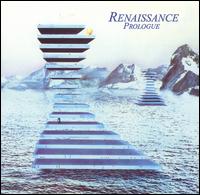 Prologue
(1972), **1/2
Prologue
(1972), **1/2
By
the time Renaissance recorded their third album nobody from the first
incarnation had survived. This version of Renaissance was far more
accessible, but still made a merger of rock and classical
music.
Despite the lineup turnover, their sound still focuses on piano, and
the guitar is still in a backwater. Pianist John Tout knows
enough to not dump classical works wholesale into the songs, but
tends to fill up the sound by quickly overplaying (the title track is
almost dizzying). Since so much of the focus on the piano and
the vocal harmonies, it is almost piano-based folk music, like
Fairport Convention with Rick Wakeman instead of Richard
Thompson.
Still, it's clear that the band was still organizing their thoughts
at this point - guitarist Mick Dunford doesn't appear on the album,
but is credited with arrangements (along with Tout). As well
he
should, since he wrote the bulk of the album, in conjunction with
associated lyricist Betty Thatcher. Dunford's melodies are of
the aforementioned folky/classical variety, and Thatcher seemed to
wonder around and jot down impressions, often of the sea ("Bound
for Infinity" and "Sounds of the Sea"). To
emphasize the transitional nature of this album, even a couple of Jim
McCarty melodies appear on the record - the catchy "Kiev"
being the most notable. With a chord pattern that sounds like
it was borrowed from a Russian folk song, a slow-mo disco beat, weak
male lead vocals but great group harmonies, it's like some odd
precursor to ABBA. Annie Halsam's smooth vocals are not all-out yet,
and she is presented only as That One Lady With The Really High
Range. She does not yet have the self-assuredness that marks
Renaissance's later albums, and her falsetto is pretty weak as
well.
The male vocalists are pretty bland, but combined their vocal
harmonies are pretty, well, pretty ("Sounds of the Sea").
The rhythm section (including guitarist Rob Hendry) is flexible
enough, but nothing to make you go Wowsers,
listen to that!
If Flash's rhythm section was one step removed from Yes, then John
Camp (bass) and drummer Terry Sullivan are one step further
removed.
Put all these pieces together, and you have a very poppish band which
likes to take some progressive breaks (the beautiful "Spare Some
Love" and "Kiev" both have distinctive progressive
sections). Of course, being a progressive album, the songs
are
long (only one is under 5 minutes), and there's a long
Eastern-flavored instrumental piece, "Rajah Khan" with a
loud, questionable, drawn out electric guitar intro by
Hendry.
It's their stab at big time progressive rock, and the most unusual
thing about it is guest Francis Monkman's squealing synth solo in the
middle. Mostly it's just a nice trance-inducing sound with
Halsam doing wordless harmonizing over it. Nothing
earth-shattering.
Some
of the blame can
go to the production - done by the group and Miles Copeland.
Thus, even though this was Renaissance's third album, the title of
Prologue is appropriate, as the band later got
their majestic,
orchestral classical/rock act together.
Sand
 Sand
(1973), ***1/2
Sand
(1973), ***1/2
Probably
because it was the antithesis of cool, the early 1970s' blending of
country and soft rock has never made a comeback. Sure, you
can
like the Grateful Dead or Crosby, Stills and Nash, but few are
awarded for namedropping Bread or Poco. But not all bands had
to be as brash as the Eagles or as lame as Bread. Enter Sand,
which combined the acoustic guitars and harmonies of CS&N with
a
good steel guitar player, and the intricate playing and discipline
more akin to progressive rock. Released in one of
the
more puzzling formats around-- a regular length album appearing on
one side each of two records (a gimmick that backfired when oil
prices went up and manufacturing costs increased)-- and on a
label formed to put out Andy Williams reissues (Barnaby), the band's
existence appears not have ever been noticed, much less
forgotten.
Primarily through the efforts of guitarists Jack Meussdorffer and Dan
Ross, Sand offered an expansive sound which did not venture too
deeply into country or rock. Instead the guitarists created the
light, expansive sound which their name suggests (the opening of
"Mystery" is a good example). The opening track, "Who
Ya Tryin' To Fool" is the zenith of the band's approach.
The song's vocal harmonies are straight from CS&N, as are
Meussdorffer's acoustic underpinnings, but Ross's excellent steel
guitar really makes a difference. There's a country flavor
(how
could there not be with such prodigious steel guitar?), yet it never
overpowers the music. The real surprise comes on the
instrumental breaks - the rhythm section switches to eighth notes,
and Ross starts exacting little runs. Meussdorffer then joins
in and the two trade off, before eventually intertwining their
guitars. While the band only takes advantage of
this in a
few other places ("Destined Road"), Ross's steel guitar
work and their calculated harmonies make listening to the band a
joy. The second side/disc isn't as successful as the first,
yet
the band still works the harmonies (the very CS&N-like
"Mystery"), and dual lead guitar ("Eagle's Claw"),
before closing with "Lady of Mine" which boasts a fun
sing-along chorus. Not rocking, not wussy, not political:
just
a group of guys giving it their all and making good music.
All
I know is that if I owned a label, I would re-issue this
album.
The rest of the band is Dan Wilson (vocals), Rich Gooch (bass), and
Steve Williams (drums). The group put out another album Head
in the Sand
in 1976, on the Ostrich label (which I guessing means it was self
released). Meussdorffer (as Jack Charles) and Gooch later
appeared in the 80s band Quarterflash. Produced by Ken
Mansfield.
Savoy
Brown
 Savoy
Brown: A Step
Further (1969)
Savoy
Brown: A Step
Further (1969)
I really
expected more from this group - they sound like they have potential,
and had been around a while. But as a blues band (not a bad
thing), they rely way too much on the same song format. Only
frontman Chris Youlden brings something interesting to the table -
the other band members don't have a distinct sound. This is
probably why most of the first side is masked with dated-sounding
orchestral accompaniment, and is pretty derivative. The real
problem is the second side which is a live boogie montage that starts
out as a good time and quickly deflates. I mean, 22 minutes of the
same beat in the same key (A) is going to get tiring. Along
the
way they manage to disgrace not only "Purple Haze" but also
"Hernando's Hideaway". I don't really want to rate it
because listening to the second side puts me to sleep every time.
The
Seeds
 The
Seeds (Apr.
1966), **1/2
The
Seeds (Apr.
1966), **1/2
American
garage rock is credited for being an influence on many later scenes
including late 60s and 70s Detroit, metal and punk. But while
each of those have relatively famous bands and albums, garage rock's
whole approach usually limited recognition to only a handful of
singles. If garage rock was by definition amateurish, then
the
Seeds are professional amateurs. This is certainly the case
with the Seeds' debut album, where the group takes English R&B
and turns it into a primitive sophomoric exercise. This album
isn't much more than attitude - snarling vocals (like some grotesque
caricature of Mick Jagger), distorted guitars, and occasional frenzy
("Girl I Want You") set to adolescent love lyrics.
The result sometimes borders on a cacophony of sound ("Evil
Hoodoo" which is actually an entertaining mess) but usually just
lurches between a few chords. Attitude alone cannot
compensate
for a lack of both songwriting and instrument proficiency, as many of
the songs are virtually hook free. As a result, most of the
songs never rise above the filler level, some sounding eerily like
Pretty
Things fodder
("Nobody Spoil My Fun", "Fallin In Love").
They do stumble across some interesting ideas, such as "You
Can't Be Trusted" with a list of reasons for rejecting a girl,
and a guitar distorted to the point that it sounds like a
violin.
The only notable tracks are the rebellious, yet constructed "Pushin'
Too Hard" (which was a hit), and "Can't Seem to Make You
Mine", which is remarkably hook-based. Mostly forgettable,
and forgotten. Singer/bassist Sky Saxon wrote all the songs
(I
think he concentrated on the lyrics), with only a few
co-writes.
The rest of the band is Daryl Hooper (organ, piano), Jan Savage
(guitar), Rick Andridge (drums).
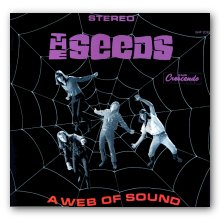 The
Seeds: Web of
Sound
(Oct. 1966), *1/2
The
Seeds: Web of
Sound
(Oct. 1966), *1/2
I gave the
Seeds the benefit of the doubt on their first review because I
admired their sound, even if they weren't able to do much with
it.
But they deprive me of that opportunity this time. On Web
of Sound the
Seeds got normal and more experimental at the same time.
There's actual production, and their sound is far more commercial,
but at the cost of sacrificing their attitude and the charm that goes
along with it. Saxon's vocals are no longer sneering, instead
his barely controlled voice and extensive diphthongs make him sound
eerily like a teenage Bon Scott (the compromise garage/pop of "Mr.
Farmer", memorable only for Saxon's drawn out sssses on the
chorus), which is not necessarily a bad thing. On their debut
the garage attitude helped mask songwriting holes, but here all the
hooks disappear as well (the slow, draining blues of "A Faded
Picture"). The result is the worst of both worlds.
Savage's guitar is really pushed down in the mix, while unremarkable
bottleneck guitar supplied by "Cooker" fights Hooper's
organ for prominence. Most of the album is early dirty blues
psychedelia ("Pictures and Designs", "Rollin'
Machine"), roughly (and I mean roughly)
comparable to English groups at this time. All the sliding
guitar and spooky organ sound do sound like a terribly early Pink
Floyd at times ("I Tell Myself"), just far worse than
Floyd ever really sounded. However, the absolute worst is "Up
In Her Room" which could be considered one of the first
psychedelic jams, if they hadn't forgotten the jam. In fact,
Saxon sort of rambles on while the band goes back and forth on the
same two chords for 14+ minutes, and nobody in the band even really
tries to solo. Andridge's drumming is entertaining for the
most
part, and the lyrics are pretty explicit for their time, but it's
still over fourteen minutes for a song that has only enough musical
interest for two, tops. Saxon even runs out of things to say
and winds up repeating the same thing over and over again towards the
end. So, let it be hailed as early psych, and let it be
condemned as a waste of everyone's time.
The Sky
 The Sky: Don't Hold
Back (1970),
**1/2
The Sky: Don't Hold
Back (1970),
**1/2
Perhaps
the only non-Motown Detroit band failing to crank it up and sonically
assault people, the Sky followed English bands like the Who and
contemporary Stones instead. Bassist/vocalist and future
Knack
leader Doug Fieger and the other band members were barely out of high
school, so why not send demo tapes to Pete Townshend and Jimmy
Miller? In a move which is formulaic in the movies and
improbable in real life, Miller responded and invited the band to
England. Miller was working heavily with the Stones at the
same
time (which is why Spooky Tooth keyboardist Gary Wright wound up
producing most of the album) and there appears to have been some
borrowing from the Stones' sessions going on next door. Thus,
the Keys-Price horn section, and backing singers Pat Arnold, Doris
Troy and Flo Bender, appear periodically throughout the
album.
Sometimes dreams come true.
As
a three-piece, the band's main approach was to make power-pop based
on the Rolling Stones' sound, and Fieger wrote the bulk of the
songs. Sometimes it works (the crunching "One
Love",
or the lesser "Goodie Two Shoes"), but mostly it does not.
Miller, Wright and friends make them sound like a contemporary
English band periodically with building horns, trashy female gospel
backed choruses, whistle-clean sound (the expansive "Take Off
and Fly", "Feels Like 1000 Years"), but only a
second-class one at best because many songs sound unfinished, or
don't really go anywhere (the nice sounding "Homin' Ground"
is certainly perplexing). For example, the leadoff track "Goodie
Two Shoes" never truly ventures beyond its initial riff, and its
lyrics are neither really a story nor a series of portraits.
The songs are not that long, but the band just doesn't have much to
say, and could condense ("Make It Time", "Feels like
1000 Years" is a good song, but could be cut in half).
Guitarist/keyboardist John Coury plays well enough to not embarrass
himself, but never gets to the "cutting it loose" stage.
Fieger gets a little two wrapped up in his cock-rock-lite
surroundings on the atrocious/funny "How's That Treating Your
Mouth, Babe?" responsible for the album's "Certain portions
of this album may not be suitable for broadcast purposes"
warning.
The
proximity to some better-known names can create embarrassing
situations as will, such as "There in the Greenbriar" - a
folky Traffic knockoff with real live Traffic
member Chris Wood as a guest. All it does it highlight how
good
the real Traffic was. The same is felt when all the
session folks are on a track - it makes unfavorable comparisons
easy.
So
if you had ever wondered how great the impact a producer can have on
a band, here's a good case study. We can therefore safely
conclude that it is more than the producer at work on those Stones
albums. Bottom line: Fungible.
It
looks
like they had some trouble with their drummer, one Bob Greenfield,
who plays on the album but afterwards was replaced by a Rob
Stawinski. (Yes
psychotics take note -
Alan White drums on unspecified tracks). The group recorded
one
more album, Sailor's
Delight,
the following year. I've read that this was done in the
Stones'
mobile studio right after the Who were recording Who's
Next (or
portions). So, in a sense - the Sky were next.
Their
sound is supposedly different, but I don't have a copy, and don't
anticipate ever finding one. Courey later became John Corey
and
played with members of the Eagles and Rod
Stewart.
Skylark
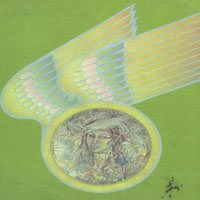 Skylark
(1972), *
Skylark
(1972), *
Almost
by definition pop music sounds good or pleasant, and the best
examples do much more. Sadly, more often than not, pop stars
have their six months of fame but lack the talent to carry it
further. Part of the reason is that often these groups are
merely singers, not instrumentalists or songwriters, which hurts
their ability to produce in the long run. Once the
song/production machine supporting them switches elsewhere, they are
left as has-beens, and often deservedly so. Is Skylark a
band?
It certainly looks like it on the outside, even though their group
suspiciously consists of two lead vocalists, a piano player and a
drummer. It turns out however that they are towards the
manufactured end of the pop spectrum, and this is proto-adult
contemporary. The production focuses on the singers, Donnny
Gerrard and B. J. Cook, who are the smooth, soulful, and Canadian
version of Bonnie and Delaney (without the marriage), although
Gerrard is clearly the better singer. However, the album's
main
figure is David Foster, who is credited with piano, arrangements,
string arrangements, and "assisting in production" on the
album. He later moved onto things such as inventing "adult
contemporary" through churning out power ballads, running over
African-American Broadway stars, unleashing Celine Dion on an
unsuspecting world, and having a reality show based on his
life.
This (the adult contemporary aspect) is what
he did on this album as well--Skylark had a built-in pop factory to
add schmaltzy orchestral arrangements and the like. Of
course,
no matter how smooth you make the sound, or how many session men you
hire, you're really only as good as your material. Skylark's
songs are drawn from a great variety of semi-crappy places - some
names you may recognize (Dominic
Troiano's
"Writing's on the Wall", the Mann-Weil machine, even a Fats
Domino cover) to anonymous hacks (the Gaye/Terrell knockoff "What
Would I Do Without You") and even session guitarist Doug Edwards
gets some credits in (co-writing the group's lone hit "Wildflower"
with a Canadian policeman). It's all the usual
semi-depressing
70s crap for the most part, so let's take a look:
|
Song
|
Summary
|
|
"Brother Eddie"
|
Sinful minister runs skid row mission.
|
|
"What Would I Do Without You"
|
Self-explanatory.
|
|
"A Long Way to Go"
|
"I may have come a long way / but I've still
got ..."
|
|
"Suites for My Lady"
|
An orchestrated phone call.
Seriously.
|
|
"I'll Have to Go Away"
|
I'm lost in the city, but it isn't easy going
away.
|
|
"The Writing's On the Wall"
|
The world sucks, but can't change.
|
|
"Twenty-Six Years"
|
I was wrong in the past, but I can still
change.
|
|
"I'm In Love Again"
|
Guess who I'm in love with? You!
|
|
"Wildflower"
|
I pity this poor young girl and wish that I
could help
her. (I thought it was about an underage prostitute at first
listen, and see no reason to change my opinion.)
|
|
"Shall I Fail"
|
If I write a crappy song, shall I fail, shall
I
fail? (Yes.)
|
Just
like candy bars, the first one may be good, but eating several in a
row is unpalatable, not to mention unhealthy. But here's the
critical question - how do you rate something like this. It's
the same problem one runs into with any truly pop artist - even the
recognized greats like Frank Sinatra. Few wrote their own
material, they just interpreted others'. Does that mean that
blatant pop music deserves it's own criteria to judge it
with?
If so, how do we determine what it is? Distinct genres like
jazz certainly do, but you can also spin off sub-genres ad nauseum
(the trap that the AMG guide tends to fall into). You can
also
say that the music itself suggests the criteria by which it should be
judged, like a song with lots of solos which are terrible is bad
because the solos are bad. However, this just skirts the
issue
- the criteria could be complete crap ("Uh - we meant to play
out of tune and be boring"). So let's take a wholly
subjective stance right here - This
music is crap, and this album is crap. It could be a guilty
pleasure for some people, but you can't cover a piece of cardboard
with tin foil and pass it off as currency. Produced
by Eirik Wangberg.
Slade
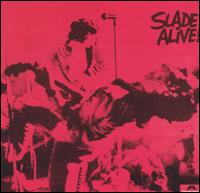 Slade
Alive! (Mar.
1972), ***1/2
Slade
Alive! (Mar.
1972), ***1/2
Listening
to a group starting with a live album is not the best idea, but this
is what appeared and is my only Slade album [Ed.
note - no longer true].
Alive!
is
the
exact opposite from the last album I reviewed, Yes's Tales
from Topographic Oceans;
it is unpretentious, earthy music with simple lyrics and little
technical skill. Instead of trying to impress the listener,
Slade drives the beat and the melody into your head. Plus,
unlike most music at this time, the band's aim was to get the
audience moving, and they try their best with lots of
interaction.
Good harmonies ("In Like a Shot from My Gun") help, and the
group's compositions aren't bad at all ("Know Who You Are").
Just in case anyone thought they were softening up, singer/guitarist
Noddy Holder burps during a downtempo cover of John
Sebastian's "Darling Be Home Soon", one of the few
moments he isn't screaming at the audience. The back side
isn't
as interesting, with some 50s rave ups ("Keep On Rocking"
which turns into "Tutti Frutti") and a cover of "Born
to be Wild". Overall this is a fun album, aimed to
entertain instead of to shock or impress. Produced by Chas
Chandler.
The Smoke
 The
Smoke: My Friend
Jack (2000)
The
Smoke: My Friend
Jack (2000)
The Smoke were
a good sixties band with a common problem: they could not write
enough really good songs. Of course, having your first single
banned by the BBC, being dropped from your label, and having your
manager/label owner sell all your equipment also doesn't help the
career. My
Friend Jack
has almost the band's entire recorded work, including their album
It's
Smoke Time.
When the band does have a good song their musical skills make it work
well. For example, the title song is unquestionably their
finest, with its screechy feedback guitar and thinly veiled drug
references. With a album of this kind you get the
good
with the bad for the sake of completeness (bad fidelity German TV
cuts for example) and songs like "We Can Take It" and
"Victor Henry's Cool Book" show why they were B-Sides.
Perhaps the worst track is a cover Traffic's
"Utterly Simple" produced by Dave Mason and Jeff
Beck that was wisely never released. But elsewhere
Mal
Luker's scratchy feedback-ridden guitar drive songs like "Have
Some More Tea" and the excellent "High In a Room".
This is all probably irrelevant for such a cult group (a very small
cult) whose fans would already own this anyway.
Steppenwolf
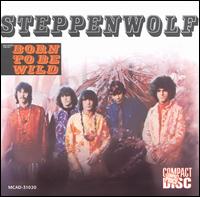 Steppenwolf
(Jan. 1968),
**1/2
Steppenwolf
(Jan. 1968),
**1/2
I'm still
trying to figure this group out -- were Steppenwolf for
real?
Were they merely a second-rate West Coast band, or one of the first
hard rock groups? Their first big hit appears on this (their first)
album, "Born to Be Wild". Steppenwolf
does
not have any real amazing display of playing prowess or songwriting
talent. The real things going for the band is an organ and a
good guitar tone. Otherwise, it turns out that they were just
another West Coast group, and not a very inspired one. What
they do come up sounds like the Byrds cranked up louder ("Everybody's
Next One") or rambling heavy psych (the political dreadful "The
Ostrich", which de-evolves into a noise collage).
Otherwise this album appears to be tributes to the bands influences -
Chuck Berry (the montage "Berry Rides Again"), the blues
(represented by a cover of Willie Dixon's "Hootchie Kootchie
Man") and of course the Byrds
("Everybody's
Next One", and about every other group-penned number). The
only other songs of interest are the covers of Don Covay's "Sookie
Sookie" and an excellent, moody rendition of "The Pusher",
written by Hoyt Axton. Produced by Gabriel Mekler.
I'm
not feeling that motivated to look up the group members, so all I
really know is that John Kay is the vocalist and wrote or co-wrote
all of the non-covers. With the exception of "Born to Be
Wild" that is, which was written by departed group member, Mars
Bonfire.
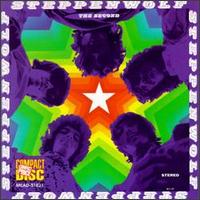 Steppenwolf
the Second (Nov.
1968),
**1/2
Steppenwolf
the Second (Nov.
1968),
**1/2
This
album is better, but also worse (such is life). Steppenwolf
dropped their folk influences for the blues (Kay was originally a
blues singer), which sounds like a novel idea. However, they
manager to screw it up, mainly by rewriting Junior Wells' "Messin
with the Kid" as "Tighten Up Your Wig", which annoys
the hell out of me. Yes, they play around with a slide guitar
to a bit of success, but this brings up the group's major flaw -
nobody can solo worth a damn on guitar. Their second big hit
"Magic Carpet Ride", aside from being almost the same as
"Born to be Wild", has no guitar solos to speak of, only
feedback laden sounds now and again. On the rest of the album
this problem becomes apparent, as their rock songs just die in
instrumental breaks because there's little talent propping it up
("Faster Than the Speed of Life", another Mars Bonfire
leftover). Kay's voice wavers between asset and liability as
well. On the hard rock and blues songs it works, but when he
tries to lighten up his voice grates, like on the acoustic and
strings-enhanced "Spiritual Fantasy" where Kay blathers
about universal religion. The album's high point is the
connected blues tracks on the second side (which I can't separate
well). It starts out slow and soft, just an acoustic guitar,
Kay's voice and birds chirping ("Disappointment Number
(Unknown)"), then builds to a good pace and song ("Lost and
Found by Trial and Error"?). From then on (about halfway
through) it dissolves into a blues jam which doesn't do much.
After that it turns into a song with a hilarious chorus "Shake
your moneymaker / Shake it just for me" before ending
dubiously. Typically, the only other song I enjoy is the
piano-rocker "28" written by the producer Gabriel Mekler.
So, this album is better than their previous one overall, but lacks
more than one or two really good numbers and has some mistakes as
well (hence the same rating as Steppenwolf).
Stone the Crows
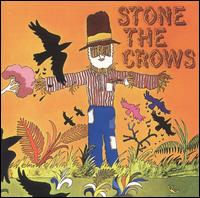 Stone
the Crows
(1970),
***
Stone
the Crows
(1970),
***
Stone
the Crows' debut belongs to a pretty nebulous genre - English Soul -
which may exist, but is not particularly relevant. Any genre
whose best known figure is probably Joe Cocker is going to be
intermittent at best. Besides, if you really wanted to listen
to soul music, you could always turn to the traditional artists like
Aretha!, Ray Charles or any number of others for the original
thing.
Instead, soul music often becomes an excuse for vocalists to let
their voices hang out to dry, and for those who can sing, but not
prettily, to be a vocalist. I love British music from this
period to death, but only because they usually were more interesting
than their American counterparts. Not so
here.
As
far as soul groups go, Stone the Crows were a bit different in that
they had both a male and female lead singer in Maggie Bell and
bassist Jim Dewar. Bell is a female Rod Stewart - she has a
scratchy voice which many may find unbearable, while Dewar sounds
like he's had a few too many of his namesake. Their voices
are
dangerous. When the aural sandpaper only rubs you for a
minute,
appreciation doesn't get a chance to turn into annoyance.
When
they let their vibrato waggle their uvulas there's little reason to
listen (the slow, painful death of "The Touch of Your Loving
Hand"). Thank goodness the band is pretty good. The
band's non-vocal center is guitarist Les Harvey, whose versatility
and songwriting talent give the band's sound enough depth to balance
the vocals. Harvey deftly fits into that tier of lesser-known
guitarists who might have reached the fame and fortune (see future
Dewar employer Robin Trower),
and he
does a solid job. When he decides to bang the blues out on an
acoustic guitar, with Bell wailing along, it's heartfelt and
effective ("Blind Man"). Nor is their bluesy cover of
the Beatles' "Fool on the Hill" half bad; the band does the
song a bit slower and with more bluesy grit, of course. They
also sound like post-Fisher Procol
Harum on
"Raining in Your Heart", which feels the same as "Whisky
Train" - soul vocals, fast paced drumming, blues leads, organ,
the works.
The
back side of the album is the most interesting - "I Saw America"
- which is somewhere between progressive rock and the Who's "A
Quick One While He's Away", and was written by Harvey, drummer
Colin Allen and producer Mark London. Much as the
title
implies, the song moves from section to section, reflecting on
various aspects of America. The sound is pretty varied -
ranging from straight progressive rock to folky, to bluesy, to
psychedelic. The lyrics are a bit weak in spots ("Have you got
any spare change, man / is a cry you'll often hear" - oof!), but
the playing is really good. For all the band's faults, it is
fascinating to hear a soul-based attempt at progressive rock, even if
it never went anywhere.
The
band released three more albums, but keyboardist John McGinnis and
Dewar left after the next album. Harvey was accidentally
killed
before their final album, preventing any lasting success.
Dewar
became Robin Trower's sideman. Drummer Colin Allen was a
graduate of the John Mayall Blues School, and the future Wings
guitarist Henry McCulloch was Harvey's replacement.
Tranquility
 Tranquility:
Silver (1972),
**
Tranquility:
Silver (1972),
**
George Harrison made an album (Electronic
Sound)
based on the idea that some music would become almost instantly
disposable - sort of an album a day thing. This was only an
extension of existing practices - many singles and albums were
released which provided limited entertainment, after which they would
be disposed of, and easily replaced. Tranquility was one of
these bands, consisting of rather faceless individuals and playing
rock which relied on more famous faces. This is the band's
second album, after an eponymous debut the year before. Lead
guitarist/lead vocalist/dominating songwriter Terry Shaddick appears
to have been in love with both late-era Beatles and West Coast soft
rock, mainly Crosby Stills & Nash. The Beatles
influence
appears in varying degrees, from borrowing the bass line to "Come
Together" ("Can I See You"), a McCartney-esque retro
song ("Dear Oh Dear"), or Abbey
Road
plundering (the title track). In addition to these
infractions,
the vocal harmonies for most of the album sound a great deal like a
combination of both Abbey
Road
and CS&N's first album ("Can I See You" where it goes
back and forth). As for Tranquility's own sound, it is a
quite
listenable soft rock one, with uncomplicated solos, simple rhythm
section and two lead guitarists (who trade off instead of
duel).
In accordance with contemporary norms Tranquility softened their
chords (making many of them semi-crappy light jazz ones) and
de-emphasized most of the playing in order to focus on their
carefully made vocal harmonies. Lyrically, the album is no
great shakes either. The opening track, "Eagle Eye"
is one of the few where they sound like themselves, and is good to
boot. There are slight dabbles into other forms--the oddly
danceable light funk of "Couldn't Possibly Be" and the
country rock of "Linda" are two good examples, even if the
latter suffers identity issues, sounding like early
Poco.
One could spend a great deal of time simply noting what Tranquility
sounds like, above and beyond what I have already written.
The
result is an album that sounds like it could have been made either
side of the Atlantic, although the group was English.
Entertaining, even fun in places, but utterly derivative.
Both
Shaddick and other lead player Berkeley Wright are competent
guitarists, with someone doing a rather good job on slide during
"Linda". Otherwise the band if Tony Lukyn (keys),
Kevin McCarthy (rhythm guitar), Bernard Hagley (bass), Paul Francis
(drums). Shaddick co-wrote "Let's Get Physical" or
"Physical" which was a hit for Olivia Newton-John, and no I
am not making that up. Produced by Ashley Kozak.
The Turtles
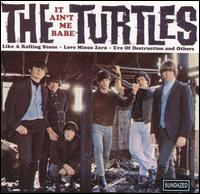 The
Turtles: It
Ain't Me Babe (Oct.
1965),
***
The
Turtles: It
Ain't Me Babe (Oct.
1965),
***
At the start, the Turtles were a more of
a rock
band, and scored their first hit with
the Dylan-penned title track. With this album, the group
already focused more on vocals than instrumentation, as reflected in
some of their covers ("It Was a Very Good Year", later done
by Sinatra, and Kurt Weil's "Glitter and Gold"). A
strong Byrds influence is pervasive, with three Dylan songs ("Love
Minus Zero" and the obligatory "Like a Rolling Stone")
as well as other covers ("Eve of Destruction", a hit for
Barry McGuire). Singer Howard Kaylan is the only group member
writing, and most of it is studied filler (social commentary on "Let
the Cold Winds Blow" for example), with the exception of
"Wandering Kind" which sounds like the Beach Boys covering
the Byrds, and is quite
good. The Turtles
had more punch than the Byrds, even borrowing the trademark drum
line from the Dave Clark Five's "Bits and Pieces" for the
two-chord romp "Your Maw Said You Cried". This album
is more raw and interesting than some of the commercial pap that they
would later record.
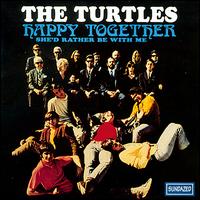 The
Turtles: Happy
Together (Apr.
1967),
***1/2
The
Turtles: Happy
Together (Apr.
1967),
***1/2
Victims of
their own success, the Turtles' controllers had moved them into
polished, overproduced pop-rock. Kaylan and Volman are
accordingly treated like the American Peter & Gordon (but with
alternating vocals, although it's hard to tell them apart)--they get
top rate songwriters (Bonner & Gordon mainly) and plenty of
horns
and strings. Think of the Monkees, whose producer Chip
Douglas
was the Turtles' bassist for a short period. The
title track
nails it - romance lyrics, orchestration, loud rhythm
section, interacting backing harmonies. Within this genre the
stuff works, and there are others songs that do it almost as well
("She'd Rather Be With Me", "Guide for the Married
Man"). "Too Young to Be One" is a catchy
acoustic number, but the melody is copied straight from the
traditional "Tis a Gift to Be Simple" (not the group's
fault). I don't know if the Turtles functioned as a
group
here or if the instruments may have been handled by session
men. Distinguishing the rhythm guitar
from
the lead is also a moot point, as the album has no solos.
They
had a new competent, but unobtrusive rhythm section of John Barbata
(drums) and Jim Pons (bass), while the guitars get pushed back in the
mix during most songs. The group's own more imaginative
contributions are the really interesting part of Happy
Together.
The band used many of the same production techniques, except that the
guitars are audible, and offer goofy-to-pass-the-label-censors social
commentary again ("The Walking Song"). One senses
that even faintly psychedelic tricks like the backwards hand claps in
the slightly devious "Person Without a Care" had to receive
approval. The greatest example is "Rugs of Woods &
Flowers" which sounds like a strange Russian naval march, but
with intentionally overwrought lead vocals, goofy backing ones
(including coughing), and the same straight orchestration.
Nothing like a self-parody. In the end the album is half
guilty
pleasure, half casual winking at the listener. Produced by
Joe
Wissert. (White Whale WW S-7114 LP)
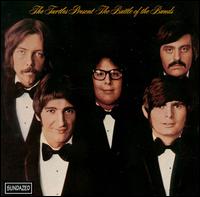 The
Turtles Present the
Battle of the Bands
(Nov. 1968), ***
The
Turtles Present the
Battle of the Bands
(Nov. 1968), ***
Not a particularly high concept, but a
concept
nonetheless - The
Battle of the Bands
featured the Turtles posing as a different group for each track. While
I don't think the band put this much thought into it, the sampler
approach was a pretty sharp comment on popular music at the time -
bands were concocting psychedelia by tackling a billion genres, yet few
ranged as wide as this. Maybe it was commentary, as everything
is pretty tongue-in-cheek - the LP has pictures of the band posing in
various ridiculous costumes, with fitting names like The
Atomic Enchiladas who perform the harmless,
tripped out "The Last Thing I Remember". Some
of the tracks are polite genre numbers such as the country-n-western
"Too Much Heartsick Feeling" or the organ-led soul piece "Buzzsaw" or
the goofy "Surfer Dan" by The
Cross Fires (an early name for the band), while the joke
"We're the Royal Macadamia Nuts" openly mocks some of the novelty bands
of the era. Yet, the
Turtles' strength was pop music, and "Oh Daddy", a fun Kinks-style rock
song, and the album's two hits show that. The first,
"Eleanore"
is openly jokey ("gee I think you're swell") but still the song is
catchy beyond belief, aided by the band's vocal harmonies.
The
second, "You Showed Me" was an unotherwise unheard Gene Clark/Roger
McGuinn song, somewhat reminiscent of the Zombies - built around a slow
organ with Kaylan and Volman trading hushed vocal lines.
It's
goddamn beautiful, and utterly sincere (so I think). Both
songs
have also aged really well, partially due to former bassist turned
successful Monkees producer Chip Douglas quietly using the nascent
synthesizer on both tracks. The odd spectrum of deliberately
fake,
possibly true and so on, makes it hard to tell where the final number
("Earth Anthem" attributed to All)
falls. It's folky, with something of Simon &
Garfunkel in it
- acoustic guitars, strings, the works while the band sings a simple
song about Earth. Borderline schlock (it could serve as the
basis
for a passé mass celebrity sing-along), I'm hopeful it's a sincere
statement, for it would lose something if it were merely a commentary.
A pretty nice album, even if the highlights are most likely
going
to appear on any best-of.
Ultimate Spinach
A producer
named Alan Lorber
decided to create a movement akin to those happening on the West
Coast, and hyped up the "Bosstown Sound" of Boston.
Scarily enough this band was the biggest thing to come out of this
artificial movement, and despite their declaration that "top 40
is not where it's at, anymore" their first album made the Top
40. After originally buying it I thought so highly of it I
gave
it away to a friend who likes spinach almost immediately.
Record
courtesy of K.J. Regis.
 Ultimate
Spinach
(1968),
*1/2
Ultimate
Spinach
(1968),
*1/2
If you can
move beyond this group's immensely stupid name, you will discover a
psych-pop failure, but like so many failures, an interesting
one.
This third-string band's main force was Ian Bruce-Douglas, a
multi-instrumentalist with a predilection for bad, pretentious lyrics
(as if the band name didn't give it away). Musically,
Ultimate
Spinach sound like Jefferson Airplane without any talent (the
harmonies on "Your Mind is Reeling"), but with
Bruce-Douglas doing a cut-rate Doors organ impression all over the
place ("Ego Trip"). Some of the real trouble is with
Bruce-Douglas' lyrics: he's concerned with very contemporary topics
such as the interaction between the hippies and the squares ("Funny
Freak Parade"), acid trips ("Pamela") and war
objectors ("Dove In Hawk's Clothing"), making the album
very dated. The spoken intros to each side are so bad (and
laced with unnecessary sitar) that one can almost hear Frank Zappa
uttering sounds of disgust. Granted not everything is
terrible,
as "Plastic Raincoats/Hung-Up Mind" and "Dove in
Hawk's Clothing" both have a nice sort of bluesy
laughing-down-one's-sleeve feel, and are adequate. The best
tracks are instrumental ("Sacrifice of the Moon" and
"Baroque #1" which borrows from Eric Satie for parts), if
that tells you something. None of the band has much to say in
terms of musical innovation or talent, resulting in scenarios where
one is waiting to hear the solo, only to discover that was had been
going on was the solo ("Your Mind is Reeling"). There
are also plenty of psychedelic touches such as spacey noises and
backwards clips. The only exception is when Bruce-Douglas
cribs
from classical composers ("Pamela"). The absolute
nadir, perhaps for the whole psychedelic movement, is "Hip Death
Goddess". After an unintentionally hilarious spoken intro,
guitarist Barbara Hudson sings in a thin voice, while in the long
instrumental section the band discovers that they cannot solo at all,
and instead engages in such scintillating tasks as producing small
amounts of guitar feedback. Although not factored into the
rating, the album contains so-bad-you-have-to-see-it-to-believe-it
liner notes, some of which have been reproduced here.
The band is Ian Bruce-Douglas (mainly keyboards), Barbara Hudson
(guitar), Keith Lahteinen (drums), Richard Nese (bass), and Geoffrey
Winthrop (lead guitar). Yes, they had a female guitarist
which
is unusual for this era. This lineup released a second album,
and an almost new one released a final, third album. Nobody
from the original band did anything interesting afterwards.
Produced by "Bosstown" mastermind Alan Lorber. (LP MGM
SE-4518).
Uriah Heep
If
groups like Tranquility
made poor photocopies of others' work and tried to pass it off as
something new, Uriah Heep was a 6-year old attempting to copy a
famous painting with crayons. In their case that painting was
Deep Purple. That being
said, Uriah Heep does
have some good points, not that I want to cast myself as their
defender. Their music is so legendarily bad and pompous that
it's trashingly entertaining. It should be no surprise that
they were one of the unofficial models for Spinal Tap. Of
course, I can't really reflect this in my ratings, but their work can
fall into the "so bad it's good" category.
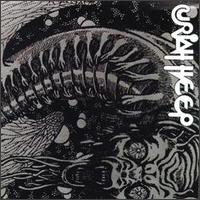 Uriah
Heep (June 1970),
*1/2
Uriah
Heep (June 1970),
*1/2
A
remarkably bad imitation of contemporary Deep
Purple. Singer David Byron sounds like the
consolation
prize in the Ian Gillan Sweepstakes (although he doesn't do any
falsetto screams), and keyboardist/guitarist Ken Hensley apparently
once heard Jon Lord's organ. Not that copying Deep Purple is
a
bad decision, it is just that the band is frankly terrible at it,
lacking most of Deep Purple's skill and all of their
innovation.
For example, the opening track "Gypsy" has the Worst
Organ Solo Ever,
as Hensley diddles around for an enormous period of time, making Lord
sound like Keith Freaking Emerson.
The
vocals are overblown and serious to the point of ridiculousness (the
gleefully pompous "Bird of Prey"), while the lyrics
approach the nadir of quality ("Real Turned On", or
"Walking In Your Shadow" which advises the listener to
"Make every cloud your slave"). While they do come up
some interesting riffs now and again, they do nothing with them, at
one point even repeating the same one over and over to kill time
("I'll Keep On Trying"). Granted, the album does have
its moments (and for the most part I literally mean moments), but
their best efforts come when they don't
try to sound like Deep Purple--their half-baked moody rendition of
Tim Rose's "Come Away Melinda" which even at half-baked is
better than most of the record, and "Wake Up (Set Your Sights)",
where they put their inherently dramatic sound to create the album's
only decent song). On the whole, it 's surprisingly
listenable,
and laughably bad. The other band members are Mick Box
(guitar), who has an awful solo in "Dreammare", Paul Newton
(bass), Alex Napier (drums) who quit during the sessions.
Produced by Gerry Bron. Originally released as Very
'umble Very 'eavy
in the UK.
Van Der Graaf
Generator
 H
to He Who am the Only One (Dec.
1970),
***1/2
H
to He Who am the Only One (Dec.
1970),
***1/2
Van
Der Graaf Generator was an early experimental art-rock band who met
little success. While other groups were goofy or romantic, H
to He Who am the Only One
would appeal more to the angst-ridden teenage crowd. Still,
it
is hard to recommend the Generator to those unfamiliar with bigger
names like King Crimson, as the band was so far out there.
The
main person responsible is lead singer/lyricist Peter Hammill, who
ran a solo career concurrently, and dissolved and recalled the
Generator at various times. Hammill, whose voice often bears
an
uncanny resemblance to David Bowie's, touches on familiar themes in
his lyrics--loneliness, death, lack of love--and he's pretty damn
good for a pretentious rock lyricist. Musically, H
to He
is an odd hybrid of King
Crimson-like
quiet sections (the intro to "The Emperor in his War-Room"
with flute) and the keyboard-filled Canterbury scene, but more
whacked out than either. The players have a fairly light
touch
and are very solid in general, but the band lacks a strong
soloist.
In fact, they arguably lacked a soloist entirely. There's no
real guitarist, even if Hammill does sporadically play, which creates
a hole in their sound. Keyboardist Hugh Banton does a good job at the
heart of things, but fails to step up, and saxophonist/flute David
Jackson seems more content with random noisemaking ("Killer"),
playing one-man woodwind section, or just repeating the song's main
lines. On the longer tracks they compensate for this by
shifting time signatures, alternating dynamics fairly dramatically,
stopping and starting music. Robert
Fripp's guest appearance ("The Emperor in his War-Room")
only demonstrates their need for a real soloist. Most of the
album (four out of five tracks) are longer songs ("Killer",
"The Emperor in his War-Room", "Lost", "Pioneers
over c"). "Killer" maintains it's beat pretty
much all the way through, but with each song the musical segments get
shorter and shorter, so that by the time "Pioneers over c"
arrives you wonder if there is any structure at all. It could
be that the music is constructed around Hammill's lyrics, a practice
that is not unusual, but taken to extremes at points. The
music
is not constrained to a beat; it is free to move along with the mood
evoked by the lyrics. Thus, the album is musically
underwritten
somewhat, and plenty of air could be let out of these songs.
The lone standout is "House with no door" - a remarkable
piano ballad by Hammill which is not only conventional in structure
and playing, but is fantastic as well. A weird album and
group,
but intriguing, even if off-putting initially. The other band
members are Guy Evans (drums) and Nic Potter (bass), of whom the
latter quit during the sessions. Produced by John Anthony.
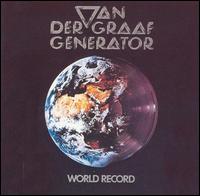 World
Record (Oct.
1976),
**1/2
World
Record (Oct.
1976),
**1/2
No, Peter
Hammill has not gone all Peter Gabriel here. Using a more cautious
approach, on World Record the band tried to reach
out to other
areas of music, and gently fold it into their prog-rock. Thus, like a
mid-life crisis, there are changes, but they are mainly just new ways
of doing old things. There are some nods towards actual “world”
music – some synthesized Spanish horns crop up in “When
She Comes” and “A Place to Survive” kicks off with
a pretty sweet 70s dance beat. Elsewhere it is merely a curiosity,
such as the band's employment of reggae beats towards the end of the
endless “Mergylus”. Some tracks pick up on bad trends
“Masks” takes cues from soft jazz and Roxy Music, with
some guzzling saxophone parts and Hammill’s nuanced vocals. The
Banton/Hammill song “Wondering” sounds like an Andrew
Lloyd Webber outtake with Hammill’s always theatrical vocals
and Banton’s faux-classical organ work. Still, give the
Generator credit for trying - most prog-rock groups had either
started retreating into pop or remained just as irascible as ever.
Hammill,
for
one, really toughened up his part of the sound. He recorded Nadir's
Big Chance - a raucous solo album, a few years earlier,
allowing
him to further develop the effective angry growl which pops up here.
Probably around the same time, he also turned the distortion up on
his electric guitar, and lost some of his (faux?) timorousness. Even
if this was the tail end of the progressive era, the songs are still
too long. Quite often the band has a good riff going, but there a
mysterious power prorogues the affair. “Mergylus” goes on
for over 20 minutes, and the other tracks could be cut in half
easily. Jackson is the only real soloist, and, poor fellow, there is
only so much a saxophone player can do. Hammill plays single notes
here and there. One thing you can never doubt is that Hammill’s
vocals are sincere – he is not being ironic or humorous when he
sings. The lack of irony prevents him from crossing over into glam
here (another dying genre), as he has the dramatic voice, the
saxophone accompanying him, and now the distorted electric guitar.
The lyrics are fine as well-- his usual assortment of solipsistic
jottings ("Merglyus III, The Songwriter's Guild", which is
pretty good as these things go), torment by women ("When She
Comes"), and similar topics, but far less navel-gazing than
Hammill's solo pieces.
The
record
sounds great, though. Hammill’s guitars and
intentionally demented vocals work well with the organ and horns. It
all has the dark tone which seems to infuse everything connected with
the band. Evans' drumming is good, and Banton’s reliance on the
organ is refreshing in a era dominated by polysynths. Also, Hammill’s
lyrics are much better, in that he does not sound conceited. To be
sure, there is some pomposity to be found, but no more than in other
groups. The main problem is that the band may have made these
changes, but they still go on for too long. At worst this makes good
background music, at best a prog-rock fan will enjoy it.
The
Wackers
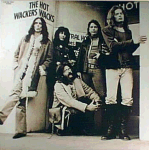 Hot
Wacks
(1972),
**
Hot
Wacks
(1972),
**
The
Wackers were a California/Canadian semi-power-pop band who really
loved Abbey
Road.
They use the same approach in track after track - acoustic guitar
with late period Beatles guitar over it: an ultra-light power-pop
group. But they lack strong vocals, relying on harmonies
which
belie their early 70s California origin. Fortunately no
pointless protectionism resulted in the banning of the real thing
(British rock) unlike the Butter/Oleo disputes of the same
area.
For this is I Can Believe It's Not English
Rock.
They play well as a group, which is to say none of them does anything
particularly interesting with their instruments. Sure, the
Wackers sound nice and former Beach Boys producer Gary Usher gives
the album an interesting sound, but this is a blessing and a curse.
It sounds really open,
which is kind of odd for a band with three
guitarists and a rhythm section. Nor is it really power-pop,
because it isn't that powerful. They have too much of that
early 70s wussy sound ("Do You Know the Reason"), despite
the fact that the band cranks it up sometimes. If one were to
make a power-pop continuum, on the heavy side would be Alice Cooper,
in the middle Big Star, and the Wackers manning the light
end.
The band also lacks strong songwriters, and their lyrics deal mainly
with love ("I Hardly Know Her Name") or vague leftover 60s
philosophy ("We Can Be"). The first side is a
patchwork of acoustic based songs and the then-in-vogue 50s sound
("Wait and See"). When the only memorable track is a
Lennon-Ono cover ("Oh My Love"), you are in trouble.
The back side is much better, and kicks off with "Breathe Easy",
which matches their acoustic sound with a catchy riff. The
remaining track is one the more presumptuous things to appear on an
American album in this era. Taking a cue from Abbey
Road,
the band decided to string a bunch of pop songs together, with a
theme at the ends ("Time Will Carry On"). To the
band's credit, it is the best track on the album, as they move on
before any ideas become stale. Certainly, someone
could
think was a power-pop gem, and wonder why Big
Star gets all the
publicity while Hot
Wacks remains
overlooked. This would be a person who hasn't heard Big
Star.
Or Badfinger. Or the Stories. Or the
Raspberries.
Hot
Wacks
passed largely unnoticed, and rightfully so. Most of the
songs
were written by guitarists Michael Stull and Robert Segarini
together, and the rest of the band is N. Randy Bishop (guitar),
William Trochim (bass) and Spencer T. Earnshaw (drums). This
was their second album, their first being Wackering
Heights.
The band relocated to Canada at some point and recorded a third
album, Shredder.
Segarini later had a solo career, and has a good reputation, but it
shouldn't be from this.
Wilderness Road
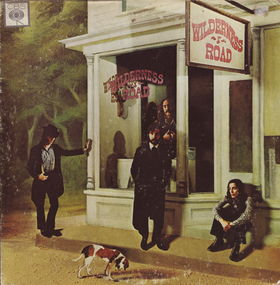 Wilderness
Road (1972), ***1/2
Wilderness
Road (1972), ***1/2
Another vinyl bin find. Wilderness Road was quite a diverse
group, although on their debut they stuck mainly to
country-rock.
Guitarist Nate Herman, who wrote most of the album, was a member of
Second City, and co-guitarist Warren Leming still works in
theatre.
Wilderness
Road is
a sort of loose country-rock concept album about a guy in the Wild
West on the run after shooting someone. The instrumentation
isn't out of the ordinary - distorted electric guitars, underlying
acoustic, a smattering of dobro - their strong melodic sense helps
make up for the fact that none f them is a strong singer, and they're
a touch over-reliant on riffs ("Wilderness", "Rider's
Return"). Comedy kicks in here with Herman's parodies,
which are clever takeoffs on rabble-rousing. The first one,
"Revival" is a medley tribute to the old tent revivals -
there's the preacher standing up there egging the crowd to "Testify",
followed by a couple of good testimonial songs ("Ten Miles"
and "Lost and Lonely Navigator") before really showing it's
all just tongue-in-cheek with the goofy "Sing Your Song to the
Lord". The other is "Dr. Morpho's Revenge",
which is a take-off on the old patent medicine salesman who used to
trawl the small towns looking for suckers ("I've got the answer
my friend / Right here in the bottle in my hand"). Another
small thing that sets them apart is Herman's use of a vocal
introduction ("Death Dream" before the acoustic ballad
"Don't Cry Lady"), which is much more likely to be found in
English folk music than American country-rock. Otherwise it's
pretty steady fare, with a good harder-rocking song ("Pictures
in an Gallery") outweighing the ending track which cannibalizes
the opening song's theme ("Rider's Return"). Fun,
good country-rock. The band is Nate Herman (guitar, vocals),
Warren Leming (guitar, vocals), Andy Haban (bass, vocals), Tom Haban
(drums, vocals). Produced by Jack
Richardson.
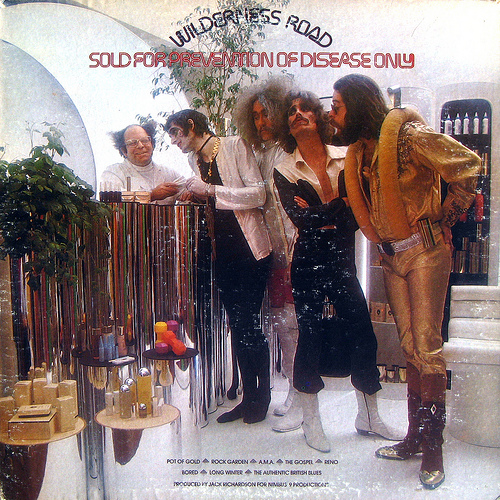 Sold
For Prevention of Disease Only (1973),
***
Sold
For Prevention of Disease Only (1973),
***
The
second and final Road album is less serious, but still lets the
singers play roles. Ultra-competent
Jack Richardson produced again, and the production sounds fuller with
the band aided by horns and backing singers ("Pot of Gold"). It's
not a concept album, but "good old rock and roll" of the roots/country
variety and satire following early Zappa, employing the members'
backgrounds with Chicago's Second City. Like
the debut, there's a gospel medley ("The Gospel"), but this time it's
clearly a joke. The album hypes the Rev. E.J. Corvette's
sermon
amongst commercials and bookended by two catchy joke songs ("What Key
Does the Good Lord Sing In?" and "Heavily Into Jesus"). The
album
ends with a parody of English Blues acts after quoting a heckler at one
of their shows, and contains the priceless couplet of "I got just the
thing baby to liberate your mind / Some asshole on a sitar playing
'Darling Clementine'" as well as a delightful impression of Robert
Plant.
The
whole thought of serious parody is worth considering for a moment.
Parody is a way to enjoy aspects of something while rejecting others -
here Wilderness Road mocks the greed and conservative aspects of radio
gospel and preachers while allowing the audience to enjoy the
music. The Byrds tried to introduce country music to the
mainstream on Sweetheart of the Rodeo, but sent mixed signals and were
rejected by the country music community. Parodies like this
allow
people to reject the establishment (in the then-contemporary
vernacular) while still participate in it; because really, you have to
know and respect something at least a bit to parody it well.
The
album's strength is really in the lyrics, followed by an ability to
parody certain styles, so the the straight stuff is not quite as good
on the whole. "Pot of Gold" and "Reno" are both good songs
aimed
at a wide audience interested in ordinary guitar-rock songs.
A
bit too heavy to be AM Gold, but something rootsy without being
overpowering or a tribute, and the band has some musical talent, but
rarely attempts solos except for some quick double-time
lines.
But, honestly, nobody is going to remember this album for those songs,
even the goofy "Rock Garden" with fake 50s vocals; they will remember
the plastic gospel songs and ads for "Mouth Jive".
Wishbone
Ash
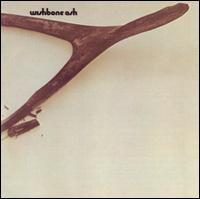 Wishbone
Ash (Aug. 1970),
***1/2
Wishbone
Ash (Aug. 1970),
***1/2
A moment on Wishbone Ash's debut neatly sums up the
complexities of British blues boom of the late 60s and the rock that
blossomed from it. After going through a veritable catalog of
blues-rock ideas (surprisingly melodic bass solo, rote drum solo,
etc) and entering the song's heart, bassist Martin Taylor starts to
scat sing. While this particular track, "Handy"
appropriately named for jazz guitarist John Handy, it tucks in neatly
among the band's interesting forays into folk ("Errors of My
Ways"), boogie ("Blind Eye"), and blues-rock ("Lady
Whiskey"). This was not uncommon, given the jazz-inflected blues
that sprang up in the late 60s in Jethro
Tull, Ten Years After and Savoy
Brown. Bassist
Tucker and drummer Steve Upton also fit this mold, as the former is
rarely content to just keep time, while the latter is very good at
just doing that quickly (even if his playing lacks imagination).
Wishbone Ash's unique hook is that guitarists Ted Turner and Andy
Powell often provide the expected hard leads in lockstep, giving the
band a unique dual lead instrument blend. This helps separate them
from both the blues specialists as well as other hard rock bands like
Led Zeppelin and Nazareth, who were also attuned to broader
influences at this time, even if they did not resort to scat singing.
Wishbone Ash were also cleaner in their sound - eschewing distortion,
putting tremolo into their notes for accentuation, and avoiding
sloppiness. They are not primarily riff soloists, although they use
them well ("Whiskey Lady"), instead usually cranking out
fluid guitar lines, shifting from idea to idea. They also use their
songs mainly as a frame for rock, instead of vanilla genre exercises
(here's our "folk" song, our "jazz" song, etc).
This is also where they sometimes get into trouble, as where their
more intense playing lacks overall structure, the songs trend towards
filler ("Queen of Torture" and the faster "Phoenix"
fall into this trap sometimes, despite some very good parts in each).
Regardless, Wishbone
Ash
is an excellent start for the group. Produced by Derek Lawrence, and
Matthew Fisher plays
piano on
"Blind Eye".
Zephyr
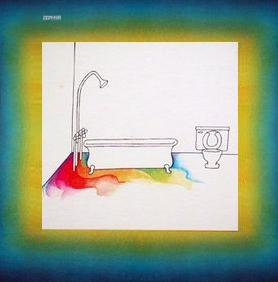 Zephyr (Oct. 1969), ***1/2
Zephyr (Oct. 1969), ***1/2
Mainly
known for having a young Tommy Bolin, Zephyr's debut is a solid
American blues album. The band's approach is pretty
consistent-- bluesy material with a strong jazz bent (like
many of those English bands which cropped up in the late 60s) with
Candy Givens' Joplin tornado vocals overlain. It may sound
boring in the abstract, but two things make this album stand out.
First, nobody in the band is below average on their
instrument. Bolin was
already a very good player, and both Candy's voice and David Givens'
moving bass lines are also good. The result is that nobody
overpowers the others. Second, the band plays around within
the genre,
unlike other blues-based bands which applied the same approach to every
rote tune. Sure, there are fine, straightforward blues
numbers
("Suns A Risin", "Huna Buna"), but they aren't the album's best spots.
The band has a good grasp of dynamics and mixing jazzy
sections
into the blues, allowing them to stretch out without becoming boring
("Sail On", "Somebody Listen"). They could also get very
heavy
for the day, with Bolin leading them into hard rock on the good "Cross
the River" before wading into jazz and even a rare, good flute solo
from the organist. While the band clearly had a good sound,
and
well-planned arrangements, a soul-shoutin' cover of the old
song
"Raindrops" seems out of place, and the closing "Hard Chargin' Woman"
is supposed to be a blow-out ender, but lacks interesting parts.
Overall, a good start.
The
band broke up after one more album, although
the Givens formed a new version a few years later. Bolin
later joined The James Gang,
and then Deep Purple.
Done taking care
of business? Return to the Music page.
 Aerosmith
(Jan. 1973),
***1/2
Aerosmith
(Jan. 1973),
***1/2
 Arbuckle
(1972), *
Arbuckle
(1972), * Bachman-Turner
II (Dec. 1973),
*1/2
Bachman-Turner
II (Dec. 1973),
*1/2
 Music
From Big Pink (Jul.
1968),
****1/2
Music
From Big Pink (Jul.
1968),
****1/2 Introducing
the Beau Brummels (Apr.
1965),
***1/2
Introducing
the Beau Brummels (Apr.
1965),
***1/2 Black
Sabbath (Feb.
1970),
**
Black
Sabbath (Feb.
1970),
**

 Blossom
Toes: We Are
Ever So Clean (Nov.
1967),
****
Blossom
Toes: We Are
Ever So Clean (Nov.
1967),
****

 Blues
Magoos: Psychedelic
Lollipop
(Nov. 1966), ****
Blues
Magoos: Psychedelic
Lollipop
(Nov. 1966), **** Bodine
(1969),
***
Bodine
(1969),
***
 Catapilla
(1971), ***1/2
Catapilla
(1971), ***1/2 Billion
Dollar Babies (Mar.
1973),
****
Billion
Dollar Babies (Mar.
1973),
****
 Air
Conditioning (Nov.
1970),
**1/2
Air
Conditioning (Nov.
1970),
**1/2 Dire
Straits (May
1978),
***1/2
Dire
Straits (May
1978),
***1/2
 Hard
Attack (1972), ***
Hard
Attack (1972), ***

 "A
Long Time Comin'"
(1968),
**
"A
Long Time Comin'"
(1968),
**
 Elephant's
Memory: Take It
to the Streets (1971),
****1/2
Elephant's
Memory: Take It
to the Streets (1971),
****1/2
 Elephant's
Memory (Sep.
1972),
**1/2
Elephant's
Memory (Sep.
1972),
**1/2
 Out
of Sight and Sound (1966),
***
Out
of Sight and Sound (1966),
*** Godfrey
Daniel: Take a
Sad Song... (1972)
Godfrey
Daniel: Take a
Sad Song... (1972)
 Gracious!
(1970), **1/2
Gracious!
(1970), **1/2
 Greenslade
(1973), ***
Greenslade
(1973), ***
 Hackamore Brick,
Hackamore Brick,  Peter
Hammill, Fool's
Mate (July
1971),
**1/2
Peter
Hammill, Fool's
Mate (July
1971),
**1/2 Peter
Hammill, In
Camera (Sep.
1974),
*1/2
Peter
Hammill, In
Camera (Sep.
1974),
*1/2 Hawkwind
(Aug. 1970), *
Hawkwind
(Aug. 1970), *
 Stop!
Stop! Stop! (1967),
**1/2
Stop!
Stop! Stop! (1967),
**1/2

 Revelation
(Jan. 1969), ***
Revelation
(Jan. 1969), ***


 Metro
(Feb. 1977), **
Metro
(Feb. 1977), ** Milkwood
Tapestry (1969), **
Milkwood
Tapestry (1969), **

 Mountain:
Climbing!
(Mar. 1970), ***1/2
Mountain:
Climbing!
(Mar. 1970), ***1/2
 The
New Mix (1968),
***1/2
The
New Mix (1968),
***1/2 New
York Dolls (July
1973),
****
New
York Dolls (July
1973),
**** More
Than a New Discovery (Feb.
1967),
***1/2
More
Than a New Discovery (Feb.
1967),
***1/2
 Eli
and the Thirteenth Confession (Mar. 1968),
***
Eli
and the Thirteenth Confession (Mar. 1968),
***
 Osibisa:
Woyaya (1971),
****
Osibisa:
Woyaya (1971),
****
 The
Peanut Butter Conspiracy is Spreading (Mar. 1967),
**1/2
The
Peanut Butter Conspiracy is Spreading (Mar. 1967),
**1/2 The
Peanut Butter Conspiracy: The
Great Conspiracy (Dec. 1967),
**
The
Peanut Butter Conspiracy: The
Great Conspiracy (Dec. 1967),
** Pearls
Before Swine: One
Nation Underground
(June 1967), **1/2
Pearls
Before Swine: One
Nation Underground
(June 1967), **1/2
 Queen
(July 1973), ***
Queen
(July 1973), ***
 A
Night at the Opera (Dec.
1975),
****1/2
A
Night at the Opera (Dec.
1975),
****1/2
 Rare
Bird (Nov.
1969), ***1/2
Rare
Bird (Nov.
1969), ***1/2
 Renaissance
(1969), ****
Renaissance
(1969), ****
 Prologue
(1972), **1/2
Prologue
(1972), **1/2
 Sand
(1973), ***1/2
Sand
(1973), ***1/2 Savoy
Brown: A Step
Further (1969)
Savoy
Brown: A Step
Further (1969)
 The
Seeds (Apr.
1966), **1/2
The
Seeds (Apr.
1966), **1/2
 The
Seeds: Web of
Sound
(Oct. 1966), *1/2
The
Seeds: Web of
Sound
(Oct. 1966), *1/2
 The Sky: Don't Hold
Back (1970),
**1/2
The Sky: Don't Hold
Back (1970),
**1/2 Skylark
(1972), *
Skylark
(1972), *
 Slade
Alive! (Mar.
1972), ***1/2
Slade
Alive! (Mar.
1972), ***1/2
 The
Smoke: My Friend
Jack (2000)
The
Smoke: My Friend
Jack (2000)
 Steppenwolf
(Jan. 1968),
**1/2
Steppenwolf
(Jan. 1968),
**1/2
 Steppenwolf
the Second (Nov.
1968),
**1/2
Steppenwolf
the Second (Nov.
1968),
**1/2
 Stone
the Crows
(1970),
***
Stone
the Crows
(1970),
*** Tranquility:
Silver (1972),
**
Tranquility:
Silver (1972),
**
 The
Turtles: It
Ain't Me Babe (Oct.
1965),
***
The
Turtles: It
Ain't Me Babe (Oct.
1965),
***
 The
Turtles: Happy
Together (Apr.
1967),
***1/2
The
Turtles: Happy
Together (Apr.
1967),
***1/2

 Ultimate
Spinach
(1968),
*1/2
Ultimate
Spinach
(1968),
*1/2
 Uriah
Heep (June 1970),
*1/2
Uriah
Heep (June 1970),
*1/2
 H
to He Who am the Only One (Dec.
1970),
***1/2
H
to He Who am the Only One (Dec.
1970),
***1/2 World
Record
World
Record
 Wilderness
Road (1972), ***1/2
Wilderness
Road (1972), ***1/2
 Wishbone
Ash (Aug. 1970),
***1/2
Wishbone
Ash (Aug. 1970),
***1/2